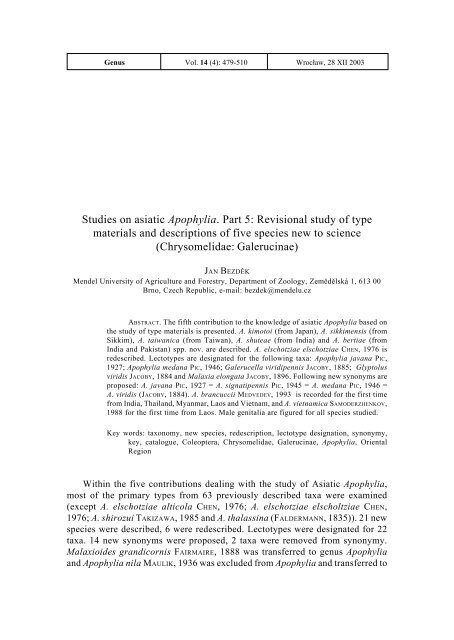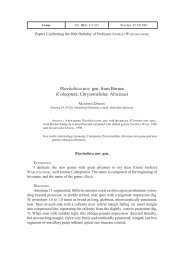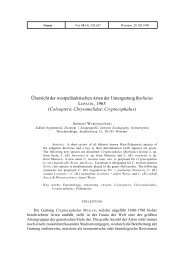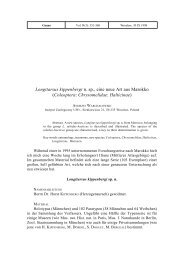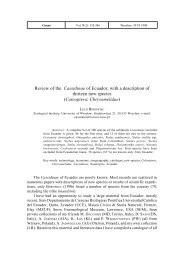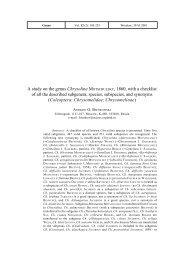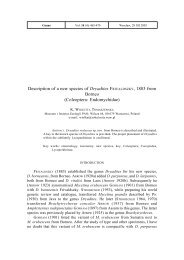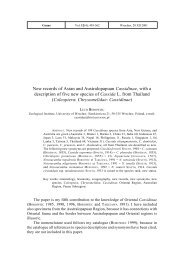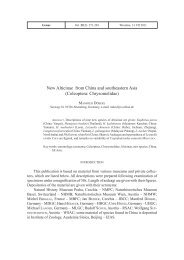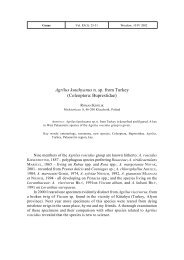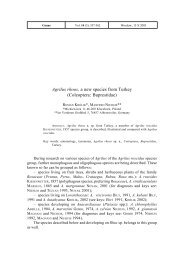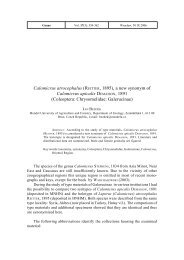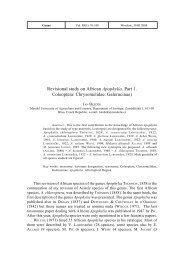Studies on asiatic Apophylia. Part 5: Revisional study of type ...
Studies on asiatic Apophylia. Part 5: Revisional study of type ...
Studies on asiatic Apophylia. Part 5: Revisional study of type ...
You also want an ePaper? Increase the reach of your titles
YUMPU automatically turns print PDFs into web optimized ePapers that Google loves.
Genus Vol. 14 (4): 479-510 Wroc³aw, 28 XII 2003<br />
<str<strong>on</strong>g>Studies</str<strong>on</strong>g> <strong>on</strong> <strong>asiatic</strong> <strong>Apophylia</strong>. <strong>Part</strong> 5: Revisi<strong>on</strong>al <strong>study</strong> <strong>of</strong> <strong>type</strong><br />
materials and descripti<strong>on</strong>s <strong>of</strong> five species new to science<br />
(Chrysomelidae: Galerucinae)<br />
JAN BEZDÌK<br />
Mendel University <strong>of</strong> Agriculture and Forestry, Department <strong>of</strong> Zoology, Zemìdìlská 1, 613 00<br />
Brno, Czech Republic, e-mail: bezdek@mendelu.cz<br />
ABSTRACT. The fifth c<strong>on</strong>tributi<strong>on</strong> to the knowledge <strong>of</strong> <strong>asiatic</strong> <strong>Apophylia</strong> based <strong>on</strong><br />
the <strong>study</strong> <strong>of</strong> <strong>type</strong> materials is presented. A. kimotoi (from Japan), A. sikkimensis (from<br />
Sikkim), A. taiwanica (from Taiwan), A. shuteae (from India) and A. bertiae (from<br />
India and Pakistan) spp. nov. are described. A. elschotziae elschotziae CHEN, 1976 is<br />
redescribed. Lecto<strong>type</strong>s are designated for the following taxa: <strong>Apophylia</strong> javana PIC,<br />
1927; <strong>Apophylia</strong> medana PIC, 1946; Galerucella viridipennis JACOBY, 1885; Glyptolus<br />
viridis JACOBY, 1884 and Malaxia el<strong>on</strong>gata JACOBY, 1896. Following new syn<strong>on</strong>yms are<br />
proposed: A. javana PIC, 1927 = A. signatipennis PIC, 1945 = A. medana PIC, 1946 =<br />
A. viridis (JACOBY, 1884). A. brancuccii MEDVEDEV, 1993 is recorded for the first time<br />
from India, Thailand, Myanmar, Laos and Vietnam, and A. vietnamica SAMODERZHENKOV,<br />
1988 for the first time from Laos. Male genitalia are figured for all species studied.<br />
Key words: tax<strong>on</strong>omy, new species, redescripti<strong>on</strong>, lecto<strong>type</strong> designati<strong>on</strong>, syn<strong>on</strong>ymy,<br />
key, catalogue, Coleoptera, Chrysomelidae, Galerucinae, <strong>Apophylia</strong>, Oriental<br />
Regi<strong>on</strong><br />
Within the five c<strong>on</strong>tributi<strong>on</strong>s dealing with the <strong>study</strong> <strong>of</strong> Asiatic <strong>Apophylia</strong>,<br />
most <strong>of</strong> the primary <strong>type</strong>s from 63 previously described taxa were examined<br />
(except A. elschotziae alticola CHEN, 1976; A. elschotziae elscholtziae CHEN,<br />
1976; A. shirozui TAKIZAWA, 1985 and A. thalassina (FALDERMANN, 1835)). 21 new<br />
species were described, 6 were redescribed. Lecto<strong>type</strong>s were designated for 22<br />
taxa. 14 new syn<strong>on</strong>yms were proposed, 2 taxa were removed from syn<strong>on</strong>ymy.<br />
Malaxioides grandicornis FAIRMAIRE, 1888 was transferred to genus <strong>Apophylia</strong><br />
and <strong>Apophylia</strong> nila MAULIK, 1936 was excluded from <strong>Apophylia</strong> and transferred to
480 JAN BEZDÌK<br />
Pyrrhalta JOANNIS, 1866. At present, the <strong>asiatic</strong> fauna <strong>of</strong> the genus <strong>Apophylia</strong><br />
comprises 68 species or subspecies.<br />
The present paper is the final c<strong>on</strong>tributi<strong>on</strong> <strong>of</strong> this series <strong>of</strong> papers dealing with<br />
the revisi<strong>on</strong> <strong>of</strong> <strong>asiatic</strong> <strong>Apophylia</strong> and includes the results <strong>of</strong> the <strong>study</strong> <strong>of</strong> <strong>type</strong><br />
materials and <strong>of</strong> additi<strong>on</strong>al unidentified material. 5 species new to science are<br />
described below, A. elschotziae elschotziae Chen, 1976 is redescribed, lecto<strong>type</strong>s<br />
are designated for 5 taxa and 3 new syn<strong>on</strong>yms are proposed.<br />
The following abbreviati<strong>on</strong>s identify the collecti<strong>on</strong>s housing the material<br />
examined:<br />
BMNH - United Kingdom, L<strong>on</strong>d<strong>on</strong>, The Natural History Museum (Shar<strong>on</strong> SHUTE);<br />
BPBM - USA, Hawaii, H<strong>on</strong>olulu, Bernice P. Bishop Museum (Al SAMUELSON);<br />
DEGG - Germany, Giessen, Dieter ERBER collecti<strong>on</strong>;<br />
DEI - Germany, Eberswalde Finow, Deutsches Entomologisches Institut (Lothar<br />
ZERCHE);<br />
FKCC - Czech Republic, Èeské Budìjovice, František KANTNER collecti<strong>on</strong>;<br />
HNHM - Hungary, Budapest, Hungarian Natural History Museum (Otto MERKL);<br />
HTHJ – Japan, Hasuda, Haruo TAKIZAWA collecti<strong>on</strong>;<br />
ISNB - Belgium, Brussels, Institut Royal des Sciences Naturelles de Belgique<br />
(Didier DRUGMAND, Marcel CLUDTS);<br />
JBCB - Czech Republic, Brno, Jan BEZDÌK collecti<strong>on</strong>;<br />
JVCJ - Czech Republic, Jirkov, Jiøí VOØÍŠEK collecti<strong>on</strong>;<br />
KMNH - Japan, Fukuoka, Kyushu, Kitakyushu Museum and Institute <strong>of</strong> Natural<br />
History (Kyoichiro UEDA);<br />
KPVI - India, Trivandrum, Vellayani, K.D. PRATHAPAN collecti<strong>on</strong>;<br />
KUEC - Japan, Fukuoka, Kyushu University (Junichi YUKAWA);<br />
MMBC - Czech Republic, Brno, Moravian Museum (Jiøí KOLIBÁÈ);<br />
MCSN - Italy, Genova, Museo Civico di Storia Naturale „Giacomo Doria”<br />
(Roberto POGGI);<br />
MCZC - USA, Massachusetts, Cambridge, Museum <strong>of</strong> Comparative Zoology<br />
(Phillip D. PERKINS);<br />
MNHN - France, Paris, Muséum Nati<strong>on</strong>al d´Historie naturelle (Nicole BERTI);<br />
NHMB - Switzerland, Basel, Naturhistorisches Museum (Eva SPRECHER-UEBERSAX,<br />
Michel BRANCUCCI);<br />
RBNN - Netherlands, Nieuwegein, R<strong>on</strong> BEENEN collecti<strong>on</strong>;<br />
SMNS - Germany, Stuttgart, Staatliches Museum für Naturkunde (Wolfgang<br />
SCHAWALLER);<br />
USNM - USA, Washingt<strong>on</strong> D.C., Nati<strong>on</strong>al Museum <strong>of</strong> Natural History (Alexander<br />
KONSTANTINOV);<br />
ZMAS – Russia, St. Petersburg, Zoological Museum, Academy <strong>of</strong> Sciences (Boris<br />
A. KOROTYAEV);<br />
ZMHB - Germany, Berlin, Museum für Naturkunde der Humboldt-Universität<br />
(Johannes FRISCH).
STUDIES ON ASIATIC APOPHYLIA<br />
481<br />
When recording the label data <strong>of</strong> the <strong>type</strong> material examined, a double slash<br />
(//) divides data <strong>on</strong> different labels. The exact label data are cited for <strong>type</strong><br />
specimens. The <strong>type</strong> localities are cited in original spelling. Other remarks and<br />
complementati<strong>on</strong>s <strong>of</strong> the author are found in square brackets: [p] – preceding data<br />
are printed; [h] – the same, but handwritten; [w] - white label; x/y - number <strong>of</strong><br />
males/number <strong>of</strong> females.<br />
<strong>Apophylia</strong> asahinai CHÛJÔ, 1962<br />
<strong>Apophylia</strong> asahinai CHÛJÔ, 1962: Philipp. J. Sci. 91: 23-26 (<strong>type</strong> locality: Musya, Taityu-syû,<br />
Formosa); CHÛJÔ, 1963: 387 (Taiwan, descripti<strong>on</strong> <strong>of</strong> female) (partim?); KIMOTO, 1965: 489<br />
(Taiwan) (partim?); WILCOX, 1971: 142 (partim?); KIMOTO, 1986: 56 (Taiwan) (partim?);<br />
KIMOTO, 1991: 9 (Taiwan) (partim?); KIMOTO & CHU, 1996: 54 (Taiwan) (partim?); CHÛJÔ &<br />
CHÛJÔ, 1997: 43.<br />
<strong>Apophylia</strong> flavovirens: CHÛJÔ, 1935: 174 (see CHÛJÔ, 1962: 23) (partim?); CHÛJÔ, 1938: 135 (see<br />
CHÛJÔ, 1962: 23)(partim?).<br />
See also A. taiwanica n. sp.<br />
TYPE MATERIAL EXAMINED<br />
Holo<strong>type</strong> (male), labelled: „Musha [h] FORMOSA [p] 26.X.1928 [h] COL.<br />
M. CHUJO [w, p] // Holo<strong>type</strong> [red label, h] // <strong>Apophylia</strong> asahinai CHÛJÔ [w, h]”<br />
(in KUEC).<br />
ADDITIONAL MATERIAL EXAMINED<br />
CHINA: Taiwan, Tungpu, Chiyai, 14.-17.vii.1976, H. TAKIZAWA leg. (2/0 in<br />
HTHJ); Taiwan, Tengpu, Nantou, 6.-8.vii.1981, H. TAKIZAWA leg. (1/0 in HTHJ).<br />
Aedeagus as in Fig. 1.<br />
Distributi<strong>on</strong>. Endemic to Taiwan.<br />
COMMENTS<br />
A. asahinai was described from single male (CHÛJÔ 1962). One year later,<br />
CHÛJÔ (1963) published additi<strong>on</strong>al specimens as “Allo<strong>type</strong>“ and “Para<strong>type</strong>s“.<br />
These specimens deposited now in NHMB (1 female) and in HNHM (5 specimens)<br />
are not c<strong>on</strong>sequently treated as <strong>type</strong> material <strong>of</strong> A. asahinai. Moreover, at<br />
least the males <strong>of</strong> this additi<strong>on</strong>al material are not c<strong>on</strong>specific with holo<strong>type</strong> and<br />
refer to A. taiwanica n. sp. together with most <strong>of</strong> additi<strong>on</strong>al material previously<br />
identified as A. asahinai, which I had the possibility to examine. Both species can<br />
be distinguished by the structure <strong>of</strong> aedeagus (Figs 1, 32).<br />
<strong>Apophylia</strong> brancuccii MEDVEDEV, 1998<br />
<strong>Apophylia</strong> brancuccii MEDVEDEV in MEDVEDEV & SPRECHER-UEBERSAX, 1998: Spixiana, 21(1): 28<br />
(<strong>type</strong> locality: East Nepal, Mechi, Dobhan-Phulvari); MEDVEDEV & SPRECHER-UEBERSAX,<br />
1999: 300; MEDVEDEV, 2000: 10.
482 JAN BEZDÌK<br />
TYPE MATERIAL EXAMINED<br />
Holo<strong>type</strong> (male), labelled: “Dobhan – 8.VI.Phulvari 1985 800-1200 m [w, p]<br />
// E-Nepal Mechi M. Brancucci [w, p] // HOLOTYPUS [p] <strong>Apophylia</strong> brancuccii<br />
m. [h] L.Medvedev det. 19 [p] 96 [red label, h]“ (in NHMB); 8 para<strong>type</strong>s<br />
(females), labelled: “Phalicot 13.VI.83 550m [w, p] // E-Nepal Arun V. M.<br />
Brancuccii [w, p] // PARATYPUS L. Medvedev det. 19. [red label, p]“ (in<br />
NHMB); 4 para<strong>type</strong>s (1 male and 3 females), labelled: “Hile-Arun R. 2000-300m<br />
23.V.1983 [w, p] // E-Nepal Arun V. M. Brancucci [w, p] // PARATYPUS L.<br />
Medvedev det 19 [red label, p]” (in NHMB); 1 para<strong>type</strong> (female), labelled: “Arun<br />
R. – Tamlingtar 26.V.83 450m [w, p] // E-Nepal Arun V. M. Brancucci [w, p] //<br />
PARATYPUS L. Medvedev det 19 [red label, p]” (in NHMB); 1 para<strong>type</strong><br />
(female), labelled: “Dharan 18.VI.85 [w, p] // E-Nepal Koshi M. Brancucci [w, p]<br />
// PARATYPUS L. Medvedev det 19 [red label, p]” (in NHMB).<br />
ADDITIONAL MATERIAL EXAMINED<br />
NEPAL: Chitwan distr., Chitwan N.P., Sauraha, 31.v.-4.vi.1997, W.<br />
SCHAWALLER leg. (2/3 in SMNS); Annapurna Mts., Marsyangdi vall., Chamje,<br />
1300-1500 m, 24.viii.1995, SCHMIDT leg. (3/2 in RBNN); INDIA: Kuma<strong>on</strong>, W<br />
Almora (1/0 in BMNH); Kuma<strong>on</strong>, E Ramganga V. (3/2 in BMNH); Uttar Pradesh,<br />
Kotdwara env., 1.-3.viii.1994, M. SNIZEK leg. (1/0 in JVCJ); Dehra Dun, Kuma<strong>on</strong><br />
Himalaya, Siwalik hills, 1940-1945 (1/0 in NHMB); Naini Tal, Bhim Tal, 609 m,<br />
viii.1961, G. SCHERER leg. (2/7 in NHMB); Kerala, Periyar lake, 900 m, 13.-<br />
20.v.1991, J. KOLIBÁÈ leg. (0/4 in NHMB); Kerala, Thekkady, Periyar lac.,<br />
77°10´E 9°34´N, 900-1000 m, 19.-27.iv.1997, R. PEŠA leg. (1/0 in JVCJ); Kerala,<br />
Cardam<strong>on</strong> hills, ca 50 km NW <strong>of</strong> Pathanamthitta near Pambaiyar riv., 77°05´E<br />
9°25´N, 300 m, Z. KEJVAL leg. (0/1 in JBCB); Tamil Nadu state, Nilgiri hills, 15<br />
km SE <strong>of</strong> Kotagiri, Kunjappanai env., 76°56´E 11°22´N, 900 m, Z. KEJVAL & M.<br />
TRÝZNA leg. (1/1 in JBCB); Tamil Nadu state, Nilgiri hills, 11 km SE <strong>of</strong> Kotagiri,<br />
Kunjappanai env., 76°56´E 11°24´N, 1100 m, C. R. PEŠA leg. (5/2 in JBCB);<br />
Assam, Kaziranga, Mikir hills, Brahmaputra, v.1961, G. SCHERER leg. (3/8 in<br />
NHMB); THAILAND: Nan-Pha Khab, 11.-15.v.1993, PACHOLÁTKO & DEMBICKÝ<br />
leg. (0/1 in JVCJ); Loei prov., Phu Kradung N.P., 1000 m, 101°49´E 16°52´N,<br />
16.-17.v.1999, M. ØÍHA leg. (3/0 in JBCB); Pal<strong>on</strong>g, 750 m, 26.-28.v.1991,<br />
19°55´N 99°06´E, V. KUBÁÒ leg. (6/7 in NHMB); same data, D. KRÁL leg. (2/3 in<br />
NHMB); Lansang N.P., 16°48´N 98°57´E, 18.-24.iv.1991, D. KRÁL leg. (0/4 in<br />
NHMB); Chiang Dao, 19°24´N 98°55´E, 600 m, 10.-16.v.1991, D. KRÁL leg. (1/1<br />
in NHMB); same data, V. KUBÁÒ leg. (0/1 in NHMB); Sangklaburi, 8.-12.iv.1991,<br />
J. FARKAÈ leg. (0/1 in NHMB); Nakh<strong>on</strong> Nayok Prov., Khao Yai N.P., 5.-<br />
6.vi.1965, P. D. ASHLOCK leg. (0/2 in BPBM); MYANMAR: Shwego Myo,<br />
x.1885, L. FEA leg. (1/1 in MCSN); Carin Chebá, 900-1100 m, xii.1888, L. FEA<br />
leg. (1/1 in MCSN); Momeit, DOHERTY leg. (1/0 in BMNH); LAOS: Louangnamtha<br />
prov., Namtha→Muang Sing, 101°19´E 21°09´N, 900-1200 m, 5.-31.v.1997, V.<br />
KUBÁÒ leg. (2/3 in NHMB); Hua Phan prov., Phu Loei N.P., Ban Sakok, 20°10´N
STUDIES ON ASIATIC APOPHYLIA<br />
483<br />
1-6. 1-5 - Aedeagus (a - dorsal view, b - lateral view): 1 - <strong>Apophylia</strong> asahinai, 2 - A. brancuccii<br />
(Para<strong>type</strong>, specimen from Nepal), 3 - A. brancuccii (specimen from India - Tamil Nadu), 4 - A.<br />
brancuccii (specimen from Thailand), 5 - A. dilaticornis, 6 - male antenna <strong>of</strong> A. dilaticornis. Scale<br />
1 mm
484 JAN BEZDÌK<br />
103°12´E, 23.-26.v.2001, J. BEZDÌK leg. (1/1 in JBCB); VIETNAM: Cuc Ph<strong>on</strong>g<br />
N.P., 100 km N <strong>of</strong> Hanoi, 2.-12.v.1991, E. JENDEK leg. (1/5 in NHMB); Cuc Ph<strong>on</strong>g<br />
N. P., 21.-22.v.1996, PACHOLÁTKO & DEMBICKÝ leg. (2/6 in NHMB); Cuc Ph<strong>on</strong>g,<br />
2.-11.v.1991, J. STRNAD leg. (2/3 in NHMB); Ha S<strong>on</strong> Binh prov., Hoa binh,4.-<br />
7.vi.1986, J. HORÁK leg. (0/2 in NHMB).<br />
Aedeagus as in Figs 2-4.<br />
Distributi<strong>on</strong>. Nepal. New records from India, Thailand, Myanmar, Laos and<br />
Vietnam.<br />
COMMENTS<br />
A. brancuccii was described from Nepal by MEDVEDEV (1998). I had the<br />
possibility to <strong>study</strong> numerous material <strong>of</strong> A. brancuccii from many SE Asia<br />
countries including the <strong>type</strong> series deposited in NHMB. The specimens are<br />
habitually identical and differ <strong>on</strong>ly very slightly in the structure <strong>of</strong> aedeagus,<br />
probably due to the geographical range <strong>of</strong> this species (Figs 2-4).<br />
<strong>Apophylia</strong> dilaticornis (JACOBY, 1894)<br />
Malaxia dilaticornis JACOBY, 1894: Novit. Zool., 1: 314 (<strong>type</strong> locality: Timor).<br />
<strong>Apophylia</strong> dilaticornis: WEISE, 1924: 183; WILCOX, 1971: 143; KIMOTO, 1990: 26.<br />
TYPE MATERIAL EXAMINED<br />
Lecto<strong>type</strong> (male), present designati<strong>on</strong> labelled: „Timor [w, h] // Type. [p]<br />
18500 [red label, h] // Malaxia dilaticornis Jac. [w, h]“ (in MCZC). The lecto<strong>type</strong><br />
is provided with <strong>on</strong>e red label: „LECTOTYPUS Malaxia dilaticornis Jacoby,<br />
1894, des. J. Bezdìk 2003”.<br />
Aedeagus as in Fig. 5, male antenna as in Fig. 6.<br />
Distributi<strong>on</strong>. Described from Timor Isl. (Ind<strong>on</strong>esia).<br />
COMMENTS<br />
JACOBY (1894) evidently described A. dilaticornis from several specimens <strong>of</strong><br />
both sexes, because he menti<strong>on</strong>ed the variati<strong>on</strong> length <strong>of</strong> the body size and sexual<br />
dimorphism. However, I had the possibility to <strong>study</strong> <strong>on</strong>ly <strong>on</strong>e male deposited in<br />
MCZC and designated here as the lecto<strong>type</strong>.<br />
<strong>Apophylia</strong> el<strong>on</strong>gata (JACOBY, 1896)<br />
Malaxia el<strong>on</strong>gata JACOBY, 1896: Entomologist, 29: 8 (<strong>type</strong> locality: Loochoo Islands [by the title]).<br />
<strong>Apophylia</strong> el<strong>on</strong>gata: WEISE, 1924: 183; NAKANE & KIMOTO, 1959: 69 (Amami-Oshima); NAKANE &<br />
KIMOTO, 1961: 18 (Ryukyu Is.); KIMOTO, 1964a: 372; KIMOTO, 1964b: 291 (key), 292 (Ryukyu<br />
Is.); KIMOTO & GRESSITT, 1966: 476 (key), 518 (Ryukyu); Wilcox, 1971: 143; KIMOTO, 1985:<br />
2 (Ryukyu Is.); KIMOTO & TAKIZAWA, 1994: 61 (drawing), 233 (key), 304.
STUDIES ON ASIATIC APOPHYLIA<br />
485<br />
TYPE MATERIAL EXAMINED<br />
Lecto<strong>type</strong> (female), present designati<strong>on</strong>, and paralecto<strong>type</strong> (female), labelled:<br />
„Archipel Liou-Kiou Ile d´Oshima Ferrié, 1895 [w, p] // Malaxia el<strong>on</strong>gata Jac.<br />
<strong>type</strong> [w, h]” (in ZMHB); 1 paralecto<strong>type</strong> (female), labelled: „Liu-Kiu archip. [w,<br />
h] // 2nd Jacoby Coll. [w, p] // el<strong>on</strong>gata Jac. [w, h] // Type [p] 18497 [red label, h]”<br />
(in MCZC); 2 paralecto<strong>type</strong>s (females), labelled: „Archipel Liou-Kiou Ile d´Oshima<br />
Ferrié, 1895 [w, p] // Museum Paris R. Oberthur 1897 [w, p] // Malaxia el<strong>on</strong>gata<br />
Jac. <strong>type</strong> [w, h]” (in MNHN). The specimens are provided with <strong>on</strong>e red label:<br />
„LECTOTYPUS [or PARALECTOTYPUS] Malaxia el<strong>on</strong>gata Jacoby, 1896, des.<br />
J. Bezdìk 2002”.<br />
ADDITIONAL MATERIAL EXAMINED<br />
JAPAN: Okinawa, Kadena AB at Hawaii, Makino with aircraft, 26.iii.1969<br />
(1/0 in USNM); Okinawa, Ikehara, 25.iv.1957, A. A. HUBERT leg. (0/5 in USNM);<br />
Okinawa, Imi SW Oyama, 1.v.1956, R. I. YECLA leg. (0/7 in USNM); Okinawa,<br />
Nago, 28.iii.1964, T. TAKARA leg. (0/1 in USNM); Amami-Oshima, Yuwan, 7.-<br />
9.iv.1956, S. MIYAMOTO leg. (1/0 in KUEC); Amami-Oshima, Kagoshima, 26.iv.-<br />
5.v.1967, H. TAKIZAWA leg. (1/1 in HTHJ), Okinawa, Hyakuna, Tamagusuku,<br />
10.iv.1979, K. KUSIGEMATI leg. (6/0 in HTHJ), CANADA: Anchorage, 9.iv1967,<br />
in aircraft, J. F. BYRNES leg. (0/1 in USNM); Anchorage, 14.iv1967, in aircraft, L.<br />
H. HERRING leg. (0/1 in USNM); VIETNAM: Saig<strong>on</strong>, 25.iv.1960, N. NEFF leg. (0/<br />
1 in USNM).<br />
Aedeagus as in Fig. 7.<br />
Distributi<strong>on</strong>: Japan (Ryukyu Isl). Collected also in Canada and Vietnam in<br />
aircrafts.<br />
<strong>Apophylia</strong> elschotziae alticola CHEN in CHEN, YU, WANG & JIANG, 1976<br />
<strong>Apophylia</strong> elschotziae alticola CHEN in CHEN, YU, WANG & JIANG, 1976: 208 (descr. in Chinese),<br />
220 (descr. in English) (<strong>type</strong> locality: Tibet: Chayu); CHEN & JIANG, 1981: 463; CHEN & JIANG,<br />
1987: 49 (Tibet).<br />
COMMENTS<br />
No material was examined. According to the original descripti<strong>on</strong>, A. e.<br />
alticola was based <strong>on</strong> four specimens deposited in the Institute <strong>of</strong> Zoology,<br />
Academia Sinica, Peking, China. A. e. alticola differs from A. e. elschotziae by<br />
less enlarged antennomeres, by extended bat-shaped black pr<strong>on</strong>otal spot, and by<br />
the higher altitude <strong>of</strong> its occurrence (CHEN 1976).<br />
<strong>Apophylia</strong> elschotziae elscholtziae CHEN in CHEN, YU, WANG & JIANG, 1976<br />
<strong>Apophylia</strong> elschotziae elschotziae CHEN in CHEN, YU, WANG & JIANG, 1976: 207-208 (in Chinese),<br />
219-220 (in English) (<strong>type</strong> locality: Tibet: Chayu); CHEN & JIANG, 1981: 462; CHEN & JIANG,<br />
1987: 49 (Tibet).
486 JAN BEZDÌK<br />
TYPE MATERIAL EXAMINED<br />
The <strong>type</strong> material was not studied.<br />
ADDITIONAL MATERIAL EXAMINED<br />
CHINA: SE Tibet, R<strong>on</strong>g Tö valley, 6500 ft., 23.v.1933, E. KINGDON WARD &<br />
R. J. H. KAULBACK leg. (1/0 in BMNH); SE Tibet, Zayul, Atakang, 9000 ft.,<br />
9.vi.1933, E. KINGDON WARD & R. J. H. KAULBACK leg. (1/0 in BMNH); same data,<br />
17.vi.1933 (0/1 in BMNH); same data, 8000 ft., 17.vii.1933 (2/0 in BMNH)<br />
COMMENTS<br />
The <strong>type</strong> material was not examined. According to the original descripti<strong>on</strong>, A.<br />
e. elschotziae was based <strong>on</strong> 30 specimens from Tibet deposited in the Institute <strong>of</strong><br />
Zoology, Academia Sinica, Peking, China (CHEN 1976). Unfortunately, the paper<br />
with descripti<strong>on</strong> <strong>of</strong> A. elschotziae is written in Chinese, with very short English<br />
summary <strong>on</strong>ly. I have found 5 specimens <strong>of</strong> A. e. elschotziae within the undetermined<br />
<strong>Apophylia</strong> material from BMNH and I decided to redescribe A. e. elschotziae<br />
as follows.<br />
DIAGNOSIS<br />
A. elschotziae elschotziae can be distinguished from its c<strong>on</strong>geners by the<br />
unique structure <strong>of</strong> antennae and by the structure <strong>of</strong> aedeagus (Fig. 8).<br />
REDESCRIPTION<br />
Body flattened, parallel-sided, densely pubescent, dull.<br />
Head black, mouthparts and clypeal margin brown. Pr<strong>on</strong>otum yellow with<br />
median black spot. Scutellum and underside black. Antennomeres 1 to 8 yellowish<br />
to brownish, gradually darkened, antennomere 1 infuscate dorsally, antennomeres<br />
9 to 11 black. Femora black, tibiae and tarsi yellow, occasi<strong>on</strong>ally infuscate. Elytra<br />
metallic green.<br />
Labrum transverse, covered by 6 pale setae in row, anterior margin sinuate.<br />
Anterior part <strong>of</strong> head semiopaque, covered by microsculpture, vertex dull, coarsely<br />
and densely puntcured. Interantennal space with small deep groove c<strong>on</strong>tinuing<br />
between fr<strong>on</strong>tal tubercles and to vertex as gradually narrowed impunctate stripe.<br />
Fr<strong>on</strong>tal tubercles large, subtriangular, distinctly elevated above vertex, lustrous.<br />
Vertex densely covered by short pale hairs. Antennae robust, 0.85 times as l<strong>on</strong>g as<br />
the body, length ratio <strong>of</strong> antennomeres 1 to 11: 18:9:15:22:17:16:10:15:7:7:15.<br />
Antennomere 8 largely extended, antennomeres 9 and 10 very short, triangularlike.<br />
Pr<strong>on</strong>otum transverse, 1.8 times as broad as l<strong>on</strong>g, widest at the first third,<br />
str<strong>on</strong>gly narrowed posteriad, semiopaque, densely covered by coarse punctures<br />
and pale hairs. Surface with two deep transverse depressi<strong>on</strong>s and two small feeble<br />
depressi<strong>on</strong>s in the posterior corners. Anterior and posterior margins slightly<br />
sinuate, lateral margins distinctly sinuate in posterior half. All margins indis-
STUDIES ON ASIATIC APOPHYLIA<br />
487<br />
tinctly bordered. Anterior angles widely rounded, posterior angles rectangular,<br />
rounded. Both anterior and posterior angles with small dent directed upwards and<br />
bearing l<strong>on</strong>g pale seta.<br />
Scutellum small, subtriangular, with rounded apex, covered by small dense<br />
punctures and short pale hairs, dull.<br />
Elytra parallel, dull. Humeral calli well developed. Elytral surface very<br />
densely covered with small c<strong>on</strong>fused punctures and short pale hairs. Epipleura<br />
distinct, gradually narrowed to apex.<br />
7-10. 7-8 - Aedeagus (a - dorsal view, b - lateral view): 7 - <strong>Apophylia</strong> el<strong>on</strong>gata, 8 - A. elschotziae<br />
elscholtziae, 9-10 - male metasternal protuberance in lateral view: 9 - A. maculicollis, 10 - A. basilana.<br />
Scale 1 mm
488 JAN BEZDÌK<br />
Macropterous.<br />
Ventral surface lustrous, finely punctured and covered by pale hairs.<br />
Basimetatarsomere 1.25 times as l<strong>on</strong>g as two following metatarsomeres combined.<br />
Body length 4.65-5.95 mm.<br />
The shape <strong>of</strong> aedeagus as in Fig. 8.<br />
Sexual dimorphism: Male: Last visible sternite with very large semicircular<br />
incisi<strong>on</strong>. Claws bifid. Antennomere 8 largely extended. Female: Last visible<br />
sternite complete. Claws appendiculate. Antennomere 8 <strong>on</strong>ly slightly extended.<br />
Distributi<strong>on</strong>. China (Tibet).<br />
<strong>Apophylia</strong> maculicollis (JACOBY, 1895)<br />
Malaxia maculicollis JACOBY, 1895: Stett. Ent. Z., 56: 71 (<strong>type</strong> locality: New. Guinea).<br />
<strong>Apophylia</strong> maculicollis: WEISE, 1924: 183; WILCOX, 1971: 145.<br />
TYPE MATERIAL EXAMINED<br />
Lecto<strong>type</strong> (male), present designati<strong>on</strong>, labelled: „N. Guinea [w, h] // 2ndJacoby<br />
Coll. [w, p] // maculicollis Jac. [w, h] // Type [p] 18494 [red label, h] // Malaxia<br />
maculicollis Jacoby TYPE [w, h]“ (in MCZC). The lecto<strong>type</strong> is provided with <strong>on</strong>e<br />
red label: „LECTOTYPUS Malaxia maculicollis Jacoby, 1895, des. J. Bezdìk<br />
2003”.<br />
Aedeagus as in Fig. 11.<br />
Distributi<strong>on</strong>. New Guinea.<br />
COMMENTS<br />
JACOBY (1896) evidently described A. maculicollis from several specimens,<br />
because he menti<strong>on</strong>ed the variati<strong>on</strong> length <strong>of</strong> the body size in his descripti<strong>on</strong>.<br />
However, I had the possibilty to <strong>study</strong> <strong>on</strong>e male deposited in MCZC and designated<br />
it as the lecto<strong>type</strong>.<br />
JACOBY obviously overlooked male metasternum modified to small protuberance<br />
directed downwards (Fig. 9). Due to this character, A. maculicollis seems to<br />
be very near to A. basilana PIC, 1945. Both species differ in colorati<strong>on</strong> <strong>of</strong><br />
pr<strong>on</strong>otum (yellow with central black spot in A. maculicollis, yellow or yellow with<br />
indistinct dark spot in A. basilana), in the structure <strong>of</strong> male metasternal protuberance<br />
(Figs 9-10) and in the structure <strong>of</strong> aedeagus (Figs 11-12).<br />
ALLARD (1889) described <strong>Apophylia</strong> maculicollis from South Africa. Later,<br />
JACOBY (1903) transferred this species into the genus Palaeoapophylia JACOBY,<br />
1903. In view <strong>of</strong> this fact, Allard´s maculicollis and JACOBY´s maculicollis are not<br />
c<strong>on</strong>generic. According to Internati<strong>on</strong>al Code <strong>of</strong> Zoological Nomenclature (59.2.),<br />
new name for JACOBY´s maculicollis is not necessary.
STUDIES ON ASIATIC APOPHYLIA<br />
<strong>Apophylia</strong> mimica SAMODERZHENKOV, 1988<br />
489<br />
<strong>Apophylia</strong> mimica SAMODERZHENKOV, 1988: In: Faun. & Ecol. Nasek. V´etnama: 75 (key), 78-79<br />
(<strong>type</strong> locality: Vietnam: prov. Zyalay-K<strong>on</strong>tum: Bu<strong>on</strong>loy).<br />
TYPE MATERIAL EXAMINED<br />
Para<strong>type</strong> (male), labelled: „Paratypus [red label, p] // SRV, Prov. Gialai-<br />
C<strong>on</strong>tum, Bu<strong>on</strong>-Loi, 40 km N Ankhe [p] 27 [h]VI 198[p]3.[w, h] // <strong>Apophylia</strong><br />
mimica [h] E. Samoderzhenkov det. [w, p]” (in LMRM).<br />
Aedeagus as in Fig. 13.<br />
Distributi<strong>on</strong>. Vietnam.<br />
<strong>Apophylia</strong> thalassina FALDERMANN, 1835<br />
Auchenia? thalassina FALDERMANN, 1835: Mém. Acad. Imp. Sci. St. Pétersbourg, II: 437-438 (<strong>type</strong><br />
locality: M<strong>on</strong>golia).<br />
Galerucella thalassina: WEISE, 1889: 569.<br />
Malaxia thalapina [sic!]: BALY, 1889: 309.<br />
Galerucesthis thalassina: WEISE, 1897: 296; JACOBSON, 1903: XV.<br />
<strong>Apophylia</strong> thalassina: WEISE, 1924: 184; WINKLER, 1930: 1316; OGLOBLIN, 1936: 139 (key), 140-<br />
141 (Chita, Mandzhuria, E M<strong>on</strong>golia, W China); WU, 1937: 887; GRESSITT & KIMOTO, 1963:<br />
427 (key), 433 (N China, M<strong>on</strong>golia, Korea); MEDVEDEV, 1992: 579 (key); WILCOX, 1971: 148;<br />
LOPATIN, 1975: 221; MEDVEDEV, 1982: 55 (key), 263; DUBESHKO & MEDVEDEV, 1989: 157;<br />
MEDVEDEV & DUBESHKO, 1992: 136; MOHAMEDSAID, 2000b: 368 (China).<br />
TYPE MATERIAL EXAMINED<br />
The <strong>type</strong> material was not examined.<br />
ADDITIONAL MATERIAL EXAMINED<br />
RUSSIA: Primorski Reg., Vladivostok env., Ryazanovka stati<strong>on</strong> near<br />
Slavyanka, 20.-21.vii.1991, U. HEINIG leg. (0/1 in RBNN); Slavyanka, E bank <strong>of</strong><br />
Amur river, 24.vi.1914 (0/1 in ZMAS); Primorski Reg., Sichote-Alin Mts.,<br />
Sokolchi, 1.-15.vii.1990, KADLEC & VOØÍŠEK leg. (0/1 in JVCJ); Chita Reg.,<br />
Zabaik. 5.vii.1912, GAVRILYUK leg. (0/1 in ZMAS); MONGOLIA: [unreadable],<br />
20.vi.1893 (1/0 in ZMAS).<br />
Distributi<strong>on</strong>. Russia (Far East), M<strong>on</strong>golia, China (?).<br />
COMMENTS<br />
The <strong>type</strong> series, originally deposited in ZMAS (KOROTYAEV 2002, pers. comm.),<br />
is now in l<strong>on</strong>gterm loan <strong>of</strong> Dr. Hans SILFVERBERG (Finland, Helsinki) and my<br />
request for short <strong>study</strong> <strong>of</strong> loaned material remained unanswered. Unfortunately,<br />
material examined comprises <strong>on</strong>ly several females from Russia and <strong>on</strong>e male from<br />
M<strong>on</strong>golia (but with broken tarsi and abdomen, so the aedeagus was not studied).<br />
Most likely, some <strong>of</strong> previous records <strong>of</strong> A. thalassina (mainly from China) may<br />
refer to A. grandicornis (FAIRMAIRE, 1888). The tax<strong>on</strong>omic positi<strong>on</strong> <strong>of</strong> both
490 JAN BEZDÌK<br />
11-14. Aedeagus (a - dorsal view, b - lateral view): 11 - <strong>Apophylia</strong> maculicollis, 12 - A. basilana,<br />
13 - A. mimica, 14 - A. vietnamica. Scale 1 mm
STUDIES ON ASIATIC APOPHYLIA<br />
491<br />
species as well as the geographic distributi<strong>on</strong> should be cleared when males<br />
A. thalassina are found.<br />
<strong>Apophylia</strong> vietnamica SAMODERZHENKOV, 1988<br />
<strong>Apophylia</strong> vietnamica SAMODERZHENKOV, 1988: In: Faun. & Ecol. Nasek. V´etnama: 76 (key), 80<br />
(<strong>type</strong> locality: Vietnam: prov. Khash<strong>on</strong>bin: Tu<strong>on</strong>gt´en).<br />
TYPE MATERIAL EXAMINED<br />
1 para<strong>type</strong> (male), labelled: „Paratypus [red label, p] // ВEЬТНАМ ÂÜÅTÍÀÌ горы ãîðû NW<br />
Áàé–òóîíã Бай–туонг ó у Ланг–тянь Ëàíã–òÿíü [p] 17. [h] 4.1963 ã. г. Кабаков<br />
Êàáàêîâ [w, p] // <strong>Apophylia</strong><br />
vietnamica [h] E. Samoderzhenkov det. [w, p]” (in JBCB); 1 para<strong>type</strong> (female),<br />
labelled: “Vietnam-Ha S<strong>on</strong> Binh Thu<strong>on</strong>g tien, 10 km W Kim Boi, 28.X.-13.XI.<br />
1978, L. Medvedev leg. [w, p] // Cordia [w, h] // Paratypus [red label, p] //<br />
<strong>Apophylia</strong> vietnamica Samoderzhenkov det. Medvedev 1988 [w, p]“ (in SMNS);<br />
1 para<strong>type</strong> (female), labelled: “Vietnam-Ha S<strong>on</strong> Binh Thu<strong>on</strong>g tien, 10 km W Kim<br />
Boi, 28.X.-13.XI. 1978, L. Medvedev leg. [w, p] // Cordia [w, h] // Paratypus [red<br />
label, p] // <strong>Apophylia</strong> vietnamica Samoderzhenkov det. [h] L.N.Medvedev det. 19<br />
[p] 88 [w, h]“ (in SMNS); 1 para<strong>type</strong> (female), labelled: “Paratypus [red label, p]<br />
// Vietnam-Ha S<strong>on</strong> Binh Thu<strong>on</strong>g tien, 10 km W Kim Boi, 28.X.-13.XI. 1978, L.<br />
Medvedev leg. [w, p] // <strong>Apophylia</strong> vietnamica [h] E. Samoderzhenkov det. [w, p]”<br />
(in HTHJ).<br />
ADDITIONAL MATERIAL EXAMINED<br />
VIETNAM: Cuc Ph<strong>on</strong>g, 20.iii.1995, K. Masumoto leg. (0/1 in HTHJ); LAOS:<br />
20 km NW <strong>of</strong> Louang Namtha, 900 m, 5.-11.v.1997, 21°09´N 101°18´E, M.<br />
ŠTRBA & R. HERGOVITS leg. (1/0 in FKCC); Hua Phan prov., Phu Loei N.P., Ban<br />
Sakok, 23.-25.v.2001, 20°10´N 103°12´E, J. BEZDÌK leg. (0/1 in JBCB).<br />
Aedeagus as in Fig. 14.<br />
Distributi<strong>on</strong>. Vietnam. New species for Laos.<br />
<strong>Apophylia</strong> viridipennis (JACOBY, 1885)<br />
Galerucella viridipennis JACOBY, 1885: Proc. Zool. Soc. L<strong>on</strong>d., 1885: 744, plate XLIV, fig.9 (<strong>type</strong><br />
locality: Kurigahara, Wada toge); WEISE, 1924: 61.<br />
<strong>Apophylia</strong> viridipennis: OGLOBLIN, 1936: 140 (key), 393 (key), 142; KIMOTO, 1964a: 372; KIMOTO,<br />
1964b: 291 (key), 292 (Japan); WILCOX, 1971: 149; KIMOTO, 1985: 2 (Japan); KIMOTO &<br />
TAKIZAWA, 1994: 61 (drawing), 233 (key), 305.<br />
TYPE MATERIAL EXAMINED<br />
Lecto<strong>type</strong> (male), present designati<strong>on</strong>, labelled: „Type H.T. [white round<br />
label with red margin, p] // Type. Sp. figured. [w, p] // Jacoby Coll. 1909-28a. [w,<br />
p] // Japan Lewis [w, h] // viridipennis Jac. [blue label, h]” (in BMNH); 1<br />
paralecto<strong>type</strong> (female), labelled: „Kurigahara. 4.VIII.-6.VIII.81. [w, p] // Japan.<br />
G. Lewis. 1910-320. [w, p] // Galerucella viridipennis Jac. [blue label, h] //
492 JAN BEZDÌK<br />
<strong>Apophylia</strong> viridipennis Jac. f [h] D. Ogloblin det. [w, p]” (in BMNH); 1<br />
paralecto<strong>type</strong> (male), labelled: „Japan. G. Lewis. 1910-320. [w, p] // Kurigahara.<br />
4.VIII.-6.VIII.81. [w, p] // A. viridipennis Jac. [h] det. K.G.Blair. [w, p]” (in<br />
USNM); 2 paralecto<strong>type</strong>s (males), labelled: „Japan Lewis [w, h] // G. viridipennis<br />
[blue label, h] // 1st Jacoby Coll. [w, p] // Type [p] 17872 [red label, h] //<br />
Galerucella viridipennis Jacoby SYNTYPES [w, h]“ (in MCZC). The specimens<br />
are provided with <strong>on</strong>e red label: „LECTOTYPUS [or PARALECTOTYPUS]<br />
Galerucella viridipennis Jacoby, 1885, des. J. Bezdìk 2002”.<br />
ADDITIONAL MATERIAL EXAMINED<br />
JAPAN: Akarira (1/0 in KUEC); Gifu Pref., Hirugano, 2.viii.1947 (0/1 in<br />
NHMB); H<strong>on</strong>shu, Nagano-ken, Nobeyama, 1300 m, 19.viii.1996, F. J. DE VRIES<br />
leg. (2/1 in RBNN); Kohukabori, Nasu Totigi, 24.vii.1993, H. TAKIZAWA leg. (3/7<br />
in HTHJ); Tatesina-Yama, Nagano, 10.x.1975, H. TAKIZAWA leg. (0/1 in HTHJ).<br />
Aedeagus as in Fig. 19.<br />
Distributi<strong>on</strong>. Japan.<br />
COMMENTS. One paralecto<strong>type</strong> is deposited also in Taiwan Agricultural Research<br />
Institute (TARI), Taichung, Taiwan (SHIH 2003, pers. comm.). However I<br />
have no possibility to <strong>study</strong> this specimen.<br />
<strong>Apophylia</strong> viridis (JACOBY, 1884)<br />
Glyptolus viridis JACOBY, 1884: Notes Leyd. Mus. 6: 63-64 (<strong>type</strong> locality: Silago, Moeara Laboe,<br />
Doesoen Tengah, Loeboe Gedang, Soeroelangoen, Mesauw, Solok, Soekadana); DUVIVIER,<br />
1885: L (Sumatra).<br />
Malaxia viridis: JACOBY, 1889: 216 (Burma); DUVIVIER, 1891: 46 (India); BALY, 1887: 268 (=<br />
Glyptolus viridis).<br />
<strong>Apophylia</strong> viridis: WEISE, 1924: 184; WILCOX, 1971: 149; KIMOTO, 1990: 27; MOHAMEDSAID, 1995: 5<br />
(Sabah); MOHAMEDSAID, 1999: 118 (Sabah); MOHAMEDSAID & HOLLOWAY, 1999: 164 (Borneo);<br />
MOHAMEDSAID, 2000a: 348 (Malaysia).<br />
Apophilia [sic!] javana PIC, 1927: L´Échange, 43: 7-8 (<strong>type</strong> locality: Java).<br />
<strong>Apophylia</strong> javana: WILCOX, 1971: 145; KIMOTO, 1990: 26. syn. nov.<br />
<strong>Apophylia</strong> signatipennis PIC, 1945: L´Échange 61: 3 (<strong>type</strong> locality: Java); WILCOX, 1971: 148;<br />
KIMOTO, 1990: 27. syn. nov.<br />
<strong>Apophylia</strong> medana PIC, 1946: L´Échange, 62: 14 (<strong>type</strong> locality: Sumatra); WILCOX, 1971: 146;<br />
KIMOTO, 1990: 27. syn. nov.<br />
TYPE MATERIAL EXAMINED<br />
Glyptolus viridis<br />
Lecto<strong>type</strong> (female), present designati<strong>on</strong>, labelled: „Sumatra Exped. [w, h] //<br />
Soeroe 4. 78 [grey label, h] // Type [p] 18495 [red label, h]” (in MCZC). The<br />
lecto<strong>type</strong> is provided with <strong>on</strong>e red label: „LECTOTYPUS Glyptolus viridis<br />
Jacoby, 1884, des. J. Bezdìk 2002”.<br />
<strong>Apophylia</strong> javana<br />
Lecto<strong>type</strong> (male), present designati<strong>on</strong>, labelled: „Java orient. M<strong>on</strong>tes Tengger<br />
4000´ 1890 H. Fruhstorfer [blue label, p] // <strong>type</strong> [w, h] // LECTOTYPE [red label,
STUDIES ON ASIATIC APOPHYLIA<br />
493<br />
p]” (in MNHN); 1 paralecto<strong>type</strong> (female), labelled: „Java orient. M<strong>on</strong>tes Tengger<br />
4000´ 1890 H. Fruhstorfer [blue label, p] // <strong>type</strong> [w, h] // TYPE [red label, p] //<br />
javana n sp [w, h] // PARALECTOTYPE [red label, p]” (in MNHN).<br />
<strong>Apophylia</strong> signatipennis<br />
Holo<strong>type</strong> (male), labelled: „Noesa Kambangan F. C. Drescher [p] 22.XI.1936<br />
[w, h] // <strong>type</strong> [w, h] // TYPE [red label, p] // Muséum Paris Coll. M. Pic [w, p] //<br />
signatipennis n sp [w, h]” (in MNHN).<br />
<strong>Apophylia</strong> medana<br />
Lecto<strong>type</strong> (female), present designati<strong>on</strong>, labelled: „Medan Mjöb. [w, p] // ?<br />
viridis Jac. [w, h] // <strong>type</strong> [w, h] // TYPE [red label, h] // medana n sp [w, h] //<br />
LECTOTYPE [red label, p]” (in MNHN); 1 paralecto<strong>type</strong> (female), labelled:<br />
„Medan Mjöb. [w, p] // PARALECTOTYPE [red label, p]” (in MNHN).<br />
ADDITIONAL MATERIAL EXAMINED<br />
THAILAND: Satun Prov., Thale Ban, 200 m, 6°45´N 100°09´E, 8.-13.iv.1997,<br />
J. KOLIBÁÈ leg. (1/0 in NHMB); Trang Prov., Khaophappha Khaochang, 200 m, 1.-<br />
13.i.1964, G. A. SAMUELSON leg. (18/3 in BPBM); MALAYSIA: Island <strong>of</strong> Perak,<br />
BAKER leg. (0/1 in USNM); Perak, Maxwell hill, 4400 ft., vi.1958, R. TRAUB leg.<br />
(0/1 in USNM); Malacca, Tengah Gebirge, P. ZOBRYS leg. (0/1 in ZMHB); Perak,<br />
Maxwell hill, above Taiping city, 900-1000 m, 12.-16.i.1995, S. BEÈVÁØ J. & S.<br />
leg. (0/1 in JVCJ); Pahang, Fraser´s hill, 110 km N Kuala Lumpur, 1500 m, 7.-<br />
10.i.1995, S. BEÈVÁØ J. & S. leg. (0/1 in JVCJ); Perak, 25 km NE <strong>of</strong> Ipoh,<br />
Banjaran Titi Wangsa Mts., Korbu Mts., 1200 m, 27.i.-2.ii.1999, P. PACHOLÁTKO<br />
leg. (0/1 in NHMB); Perak, 40 km SE <strong>of</strong> Ipoh, Camer<strong>on</strong> Highlands, Ringlet, 900<br />
m, 4°25´N 101°23´E, 25.iv.-5.v.2001, M. Ø ÍHA leg. (0/2 in JBCB); Benom Mts.,<br />
15 km E Kamp<strong>on</strong>g D<strong>on</strong>g, 700 m, 3°53´N 102°01´E, 1.iv.1998, DEMBICKÝ &<br />
PACHOLÁTKO leg. (0/2 in JBCB); the same data, 24.iii.-15.iv.1998, D. HAUCK leg.<br />
(1/1 in JBCB); Sabah, Sandakan, BAKER leg. (2/11 in USNM); Sabah, Ranau,<br />
23.viii.1983, G. F. HEVEL & W. E. STEINER leg. (1/3 in USNM); Borneo, Bettotan<br />
near Sandakan (0/1 in BMNH); INDONESIA: Sumatra, Benculen, iv.1891, E.<br />
MODIGLIANI leg. (0/3 in MCSN); Sumatra, Benkoelen, Leb<strong>on</strong>g Tandai, 1920, C. J.<br />
BROOKS (0/1 in BMNH); Sumatra, Fort de Kock, 920 m, i.1922, E. JACOBSON leg.<br />
(0/1 in USNM; 0/1 in DEI); the same data, xii.1921 (0/1 in USNM); Sumatra, Fort<br />
de Kock, WEYERS leg. (3/5 in Bruxelles); Sumatra NO, Tandj<strong>on</strong>g Morawa Serdang,<br />
B. HAGEN leg. (1/1 in ISNB); Sumatra, Manna, KLAPPERT leg. (0/2 in SMNS);<br />
Sumatra N, Dolok Merangir, xii.1974, DIEHL leg. (0/1 in DEGG); Sumatra,<br />
Bungus Bucht Padang, 1.-6.xi.1908, SCHOEDE leg. (0/1 in ZMHB); Sumatra NE,<br />
Tebing-tinggi, DR. SHULTHEISS leg. (0/1 in DEI); Sumatra, Merang, DOHERTY leg.<br />
(1/1 in BMNH); Sumatra, Lamp<strong>on</strong>g, BUXTON leg. (0/2 in BMNH); Sumatra E,<br />
Riau prov., Bukit Tigapuluh N.P., 0°50´S 102°26´E, 18.-25.i.2000, J. BEZDÌK<br />
leg. (0/1 in JBCB); Java, Noesa Kemsangan, i. 1911, DRESCHER leg. (0/2 in<br />
ZMHB); Java, Baluran N.P., 14.-16.iv.1996, R. ZAJÍÈEK leg. (1/12 in NHMB);<br />
Borneo, GRABOWSKY (0/1 in Berlin); Borneo, Banguey (0/2 in ZMHB); Sarawak,<br />
R. Kapah trib., <strong>of</strong> R. Tinjar, 20.x.1932, old sec<strong>on</strong>dary forest, native collector (0/
494 JAN BEZDÌK<br />
15-18. Aedeagus (a - dorsal view, b - lateral view): 15 - <strong>Apophylia</strong> viridis (specimen from Java), 16<br />
- A. viridis (specimen from Thailand), 17 - A. viridis (holo<strong>type</strong> <strong>of</strong> A. signatipennis), 18 - A. viridis<br />
(lecto<strong>type</strong> <strong>of</strong> A. javana). Scale 1 mm
STUDIES ON ASIATIC APOPHYLIA<br />
495<br />
1 in BMNH); Sarawak, Mt. Dulit, 4 000 ft., Moss forest, 22.x.1932, native<br />
collector (0/1 in BMNH); Bali, Yeh Sumbul Negar, 5.-8.xii.1999, H. TAKIZAWA<br />
leg. (3/1 in HTHJ).<br />
Aedeagus as in Figs 15-18.<br />
Distributi<strong>on</strong>. Ind<strong>on</strong>esia (Sumatra, Java, Bali, Sarawak, Borneo), Malaysia,<br />
Thailand. DUVIVIER (1891) reported A. viridis also from India (K<strong>on</strong>bir and Tetara)<br />
and JACOBY (1889) from Burma. Both records should be verified.<br />
COMMENTS<br />
A. viridis was described according to numerous material by JACOBY (1884). I<br />
was not able to trace the depositi<strong>on</strong> <strong>of</strong> the <strong>type</strong> series, except for <strong>on</strong>e female<br />
deposited in MCZC. This female is designated here as the lecto<strong>type</strong>. PIC (1927;<br />
1945; 1946) described 3 species subsequently: A. javana, A. signatipennis and<br />
A. medana. Lecto<strong>type</strong>s are designated here for A. javana PIC, 1927 and for<br />
A. medana PIC, 1946. A. javana was described from <strong>on</strong>e couple from Java,<br />
A. medana from two females from Sumatra. Both A. medana and A. javana are<br />
c<strong>on</strong>specific with A. viridis. A. signatipennis was described from single small male<br />
with unusual wide purplish elytral suture. Besides this colour character, I did not<br />
find any morphological difference, including the shape <strong>of</strong> aedeagus, between<br />
A. signatipennis and A. viridis. All three PIC taxa (A. javana, A. signatipennis and<br />
A. medana) are c<strong>on</strong>sidered new syn<strong>on</strong>yms <strong>of</strong> A. viridis.<br />
DESCRIPTIONS OF NEW SPECIES.<br />
<strong>Apophylia</strong> bertiae n. sp.<br />
TYPE MATERIAL<br />
Holo<strong>type</strong> (male), labelled: “Dehra Dun, U.P., India, 8-9´16.H.G.C. [w, p]“ (in<br />
BMNH); 1 para<strong>type</strong> (male), labelled: “India bor. 330 m UTTAR PRADESH bor.<br />
HARIDWAR, CHILA 9.-14.8.1994 lgt. M. Snizek [w, p]“ (in JVCJ); 2 para<strong>type</strong>s<br />
(females), labelled: “Dehra-Dun 1940-45 Kuma<strong>on</strong> Himalaya leg. Liesenfeldt [w,<br />
p]“ (in NHMB); 1 para<strong>type</strong> (female), labelled: “Siwalik-Hills [w, h] // Dehra-Dun<br />
1940-45 Kuma<strong>on</strong> Himalaya [w, p]“ (in NHMB); 1 para<strong>type</strong> (female), labelled:<br />
“INDIA [p] , U.P. Varansi 1973 Lakshman Lac <strong>on</strong> Helicteres isora [h] C.I.E. A [p]<br />
6516 [w, h]“ (in BMNH); 1 para<strong>type</strong> (female), labelled: “Haldwani Divn. Kuma<strong>on</strong>,<br />
U.P. Aug´21, H.G.C. [w, p] // 3721 [w, p] // 3721 [w, p] // H.G.Champi<strong>on</strong> Coll.<br />
B.M. 1953-156 [w, p]“ (in BMNH); 1 para<strong>type</strong> (female), labelled: “Sitapur U.P.<br />
India. July, 1917, HGC [w, p] // 1402 [blue label, h] // .O. [pink label, p] //<br />
H.G.Champi<strong>on</strong> Coll. B.M. 1953-156 [w, p]“ (in BMNH); 1 para<strong>type</strong> (female),<br />
labelled: “Sitapur U.P. India. July, 1917, HGC [w, p] // 1402 [blue label, h] //<br />
<strong>Apophylia</strong> sericea Fab. Det S. Maulik 1934 [w, p]“ (in BMNH); 1 para<strong>type</strong><br />
(female), labelled: “Haldwani Dist. Kuma<strong>on</strong>, India. H.G.C. [w, p]“ (in BMNH); 1<br />
para<strong>type</strong> (female), labelled: “Kangra Valley. 4500 ft vii-x1899 Dudge<strong>on</strong> [w, p] //
496 JAN BEZDÌK<br />
<strong>Apophylia</strong> sericea Fab. Det S. Maulik 1934 [w, p]“ (in BMNH); 4 para<strong>type</strong>s (1<br />
male, 3 females), labelled: “Sitapur, W.Almora, India. H.G.C. [w, p] // <strong>Apophylia</strong><br />
sericea Fab. Det S. Maulik 1934 [w, p]“ (in BMNH); 1 para<strong>type</strong> (female),<br />
labelled: “Dehra Dun, U.P., India, 8-9´16.H.G.C. [w, p] // H.G.Champi<strong>on</strong> Coll.<br />
B.M. 1953-156 [w, p]“ (in BMNH); 4 para<strong>type</strong> (2 males, 2 females), labelled:<br />
“Dehra Dun, U.P., India, 8-9´16.H.G.C. [w, p] // <strong>Apophylia</strong> sericea Fab. Det S.<br />
Maulik 1934 [w, p]“ (in BMNH); 2 para<strong>type</strong>s (1 male and 1 female), labelled:<br />
“W.Almora, Kuma<strong>on</strong>, U.P. India. H.G.C. [w, p]“ (in BMNH); 1 para<strong>type</strong> (male),<br />
labelled: “Fyzabad, Unit. Prov., India. R.W.G.Hingst<strong>on</strong>. B.M.1923-293 [w, p]“<br />
(in BMNH); 1 para<strong>type</strong> (male), labelled: “INDIA.U.P. Deahra Dun. 1932.<br />
H.G.Champi<strong>on</strong> [w, p] // H.G.Champi<strong>on</strong> Coll. B.M. 1953-156 [w, p]“ (in BMNH);<br />
2 para<strong>type</strong>s (females), labelled: “E.Coll Laferté [w, p] // Bac<strong>on</strong> N. India [w, h] //<br />
67.56 [w, p]“ (in BMNH); 1 para<strong>type</strong> (male), labelled: “Entomologist to Govt. Of<br />
India. No. [p] 811. [h] I [p] 15.VIII.190 [p] 4 [h] Sura … B … H.M. … [blue label,<br />
partly unreadable, h] // Andrewes Bequest. B.M.1922-221. [w, p] // <strong>Apophylia</strong><br />
sericea Fab. Det S. Maulik 1934 [w, p]“ (in BMNH); 1 para<strong>type</strong> (male), labelled:<br />
“Bombay India [w, h] // G. Bryant Coll. 1919-147 [w, p] // <strong>Apophylia</strong> sp. [w, h]“<br />
(1/0 in BMNH); 1 para<strong>type</strong> (female), labelled: “Bombay India [w, p] // JCBridwell<br />
coll [p] Oct. 24 [w, h]“ (in USNM); 1 para<strong>type</strong> (male), labelled: “Mangalore India<br />
Aug´28 [w, p] // JCBridwell coll [w, p]“ (in USNM); 1 para<strong>type</strong> (male), labelled:<br />
“Margao Goa Ind [w, p] // JCBridwell coll Jul´25 [w, p]“ (in USNM); 1 para<strong>type</strong><br />
(female), labelled: “Salcete Goa India [w, p] // JCBridwell coll Jul´25 [w, p]“ (in<br />
USNM); 11 para<strong>type</strong>s (4 males, 7 females), labelled: “Mormugao Goa India [w,<br />
p] // JCBridwell coll Sep´25 [w, p]“ (in USNM); 2 para<strong>type</strong>s (females), labelled:<br />
“Mormugao Goa India [w, p] // JCBridwell coll Jul´25 [w, p]“ (in USNM); 6<br />
para<strong>type</strong>s (2 males, 4 females), labelled: “Mormugao Goa India [w, p] // JCBridwell<br />
coll Aug´25 [w, p]“ (in USNM); 6 para<strong>type</strong>s (3 males, 3 females), labelled: “India<br />
or. Nagpore [w, p] // Coll. G. Hauser [w, p] // Zool. Mus. Berlin [w, p] //<br />
<strong>Apophylia</strong> sericea Fab. [h] Det. [p] R.K.Annand [h] 19 [p] 89 [w, h]“ (in ZMHB);<br />
1 para<strong>type</strong> (female), labelled: “Coll. G. Hauser [w, p] // Zool. Mus. Berlin [w, p]<br />
// <strong>Apophylia</strong> sericea Fab. [h] Det. [p] R.K.Annand [h] 19 [p] 89 [w, h]“ (in<br />
ZMHB); 1 para<strong>type</strong> (male), labelled: “West Pakistan (WP 6) Islamabad 30.VII.<br />
<strong>on</strong> light 1970 lgt. O. Štìrba [w, p]“ (in MMBC); 4 para<strong>type</strong>s (2 males, 2<br />
females), labelled: “PAKISTAN, Punjab, Rawalpindi, at light, Aug.27,1985<br />
C.W.&L.B.O´Brien [w, p] // Askevold Coll. ´87 [w, p]“ (in HTHJ); 3 para<strong>type</strong>s (1<br />
male, 2 females), labelled: “INDIA: Kerala, Ambalayaval, 19.iv. 2003, Prathapan<br />
Coll. [w, p]” (in KPVI, 1 female in JBCB). The specimens <strong>of</strong> the newly described<br />
species are provided with <strong>on</strong>e red label: „HOLOTYPUS [or PARATYPUS]<br />
<strong>Apophylia</strong> bertiae sp. nov. J. Bezdìk det. 2002”;.<br />
DESCRIPTION<br />
Body flattened, subparallel, slightly widened backwards, densely pubescent,<br />
semiopaque.
STUDIES ON ASIATIC APOPHYLIA<br />
19-22. Aedeagus (a - dorsal view, b - lateral view): 19 - <strong>Apophylia</strong> viridipennis, 20 - A. bertiae,<br />
21 - A. assamensis, 22 - A. metallica. Scale 1 mm<br />
497
498 JAN BEZDÌK<br />
Head yellow; vertex and fr<strong>on</strong>tal tubercles can vary from brown (somewhat<br />
darker than the rest <strong>of</strong> head) to black. Pr<strong>on</strong>otum, pro- and mesosternum yellow.<br />
Scutellum yellow to black. Metasternum black with yellow posterior and lateral<br />
margins in pale specimens, or black in dark specimens. Abdomen dark brown to<br />
black. The first 3 antennomeres yellow, the rest black. Legs yellow, tarsi and<br />
apical parts <strong>of</strong> tibiae <strong>of</strong>ten infuscate. Elytra metallic dark green or blue.<br />
Labrum transverse, covered by several pale setae, anterior margin sinuate.<br />
Anterior part <strong>of</strong> head semiopaque, covered by microsculpture and by several l<strong>on</strong>g<br />
pale hairs, vertex dull, coarsely and densely punctured. Interantennal space with<br />
small deep groove. Fr<strong>on</strong>tal tubercles small, subtriangular, slightly elevated above<br />
vertex, semiopaque, covered by microsculpture. Vertex densely covered with<br />
short pale hairs. Antennae slender, 0.65-0.85 times as l<strong>on</strong>g as the body, length<br />
ratio <strong>of</strong> antennomeres 1 to 11: 13:6:12:16:16:16:17:14:12:11:12.<br />
Pr<strong>on</strong>otum transverse, 1.80-2.00 times as broad as l<strong>on</strong>g, widest at the first<br />
third, narrowed anteriad and posteriad, semiopaque, densely covered with coarse<br />
punctures and short pale hairs. Surface with feebly depressed median line, laterally<br />
with 2 large deep depressi<strong>on</strong>s. Anterior margin slightly sinuate, lateral<br />
margins rounded, posterior margin almost straight. All margins thinly bordered.<br />
Anterior angles widely rounded, posterior angles obtusely angulate, rounded.<br />
Scutellum small, subtriangular, with rounded apex, covered by small dense<br />
punctures and short pale hairs, semiopaque.<br />
Elytra almost parallel, slightly widened backwards, semiopaque. Humeral<br />
calli well developed. Elytral surface very densely covered with small c<strong>on</strong>fused<br />
punctures and short pale hairs. Epipleura distinct, gradually narrowed to apex.<br />
Macropterous.<br />
Ventral surface lustrous, finely punctured and covered by pale hairs.<br />
Basimetatarsomere 1.4 times as l<strong>on</strong>g as two following metatarsomeres combined.<br />
Body length 4.10-6.10 mm (holo<strong>type</strong> 4.30 mm).<br />
The shape <strong>of</strong> aedeagus as in Fig. 20.<br />
Sexual dimorphism: Male: Antennomeres 1 to 5 with very l<strong>on</strong>g pale hairs, last<br />
visible sternite with very large semicircular incisi<strong>on</strong>, claws bifid. Female:<br />
Antennomeres 1 to 5 with moderately l<strong>on</strong>g pale hairs, last visible sternite complete,<br />
claws appendiculate.<br />
DISTRIBUTION<br />
India and Pakistan.<br />
DIAGNOSIS<br />
A. bertiae n. sp. is variable in colour. Pale specimens (including holo<strong>type</strong>)<br />
have yellow scutellum and yellow head with brown vertex, dark specimens<br />
(populati<strong>on</strong>s from Goa, Bombay and Nagpore) have vertex and scutellum black.<br />
Except the colour difference I am unable to find any other morphological character<br />
(including the structure <strong>of</strong> aedeagus) to distinguish these two colour forms.
STUDIES ON ASIATIC APOPHYLIA<br />
499<br />
Due to l<strong>on</strong>g hairs <strong>on</strong> antennomeres 1 to 5 in male, A. bertiae sp. nov. seems to be<br />
closely related to A. assamensis (JACOBY, 1891). Both species are easily identified<br />
by the structure <strong>of</strong> aedeagus (Figs 20-21) and by the colour <strong>of</strong> pr<strong>on</strong>otum (black in<br />
A. assamensis, yellow in A. bertiae sp. nov.). The dark forms <strong>of</strong> A. bertiae sp. nov.<br />
are also similar to A. metallica JACOBY, 1904 and A. medvedevi SAMODERZHENKOV,<br />
1988, these two species differ, however, by the structure <strong>of</strong> aedeagus (Figs 22-23)<br />
and by the absence <strong>of</strong> l<strong>on</strong>g pale hairs <strong>on</strong> antennomeres 1 to 5 in male.<br />
ETYMOLOGY<br />
Dedicated to Dr. Nicole BERTI, the curator <strong>of</strong> Muséum Nati<strong>on</strong>al d´Historie<br />
Naturelle Paris.<br />
<strong>Apophylia</strong> kimotoi n. sp.<br />
<strong>Apophylia</strong> nigriceps: KIMOTO, 1964: 291 (Japan, key); KIMOTO, 1985: 2 (Japan); KIMOTO & TAKIZAWA,<br />
1994: 233 (key), 305 (Japan).<br />
TYPE MATERIAL<br />
Holo<strong>type</strong> (male), labelled: „(Kyushu) Mt. Sobo [p] 27. VII. [h] 195 [p] 3 [h]<br />
Col. S. Kimoto [w, p] // <strong>Apophylia</strong> nigriceps Laboissière [h] Det. S. Kimoto, 19<br />
[p] 72 [w, h]“ (in KMNH). The holo<strong>type</strong> <strong>of</strong> the newly described species is<br />
provided with <strong>on</strong>e red label: „HOLOTYPUS <strong>Apophylia</strong> kimotoi sp. nov. J. Bezdìk<br />
det. 2003”.<br />
DESCRIPTION<br />
Body flattened, parallel-sided, densely pubescent, dull.<br />
Head bicolorous; vertex and fr<strong>on</strong>tal tubercles yellow black; anterior part <strong>of</strong><br />
head and underside yellow. Pr<strong>on</strong>otum, scutellum and underside black. Antennae<br />
yellow with last 4 antennomeres infuscate. Legs yellow, last two tarsomeres<br />
infuscate. Elytra metallic green.<br />
Labrum transverse, covered by several pale setae, anterior margin sinuate.<br />
Anterior part <strong>of</strong> head semiopaque, covered by microsculpture, vertex dull, coarsely<br />
and densely punctured. Interantennal space with small groove. Fr<strong>on</strong>tal tubercles<br />
small, subtriangular, slightly elevated above vertex, semiopaque, covered by<br />
microsculpture. Vertex densely covered with short pale hairs. Antennae slender,<br />
0.90 times as l<strong>on</strong>g as the body, length ratio <strong>of</strong> antennomeres 1 to 11:<br />
13:8:14:20:19:17:17:17:14:14:16.<br />
Pr<strong>on</strong>otum transverse, 1.65 times as broad as l<strong>on</strong>g, widest at the first third,<br />
narrowed anteriad and posteriad, dull, densely covered with coarse punctures and<br />
l<strong>on</strong>g pale hairs. Surface with two indistinct feeble depressi<strong>on</strong>s in median line<br />
(near the middle <strong>of</strong> anterior and posterior margins), laterally with two very large<br />
deep depressi<strong>on</strong>s. Anterior margin slightly sinuate, posterior margin almost straight.<br />
All margins thinly bordered. Anterior angles widely rounded, posterior angles<br />
obtusely angulate, rounded, with very small dent directed upwards.
500 JAN BEZDÌK<br />
Scutellum subtriangular, apex widely rounded, with small dense punctures<br />
and short pale hairs, dull.<br />
Elytra parallel, dull. Humeral calli well developed. Elytral surface very<br />
densely covered with small c<strong>on</strong>fused punctures and short pale hairs. Epipleura<br />
distinct, gradually narrowed to apex.<br />
Macropterous.<br />
Ventral surface lustrous, finely punctured and covered by pale hairs. Last<br />
visible sternite with very deep semicircular incisi<strong>on</strong>.<br />
Basimetatarsomere 1.5 times as l<strong>on</strong>g as two following metatarsomeres combined.<br />
Claws bifid.<br />
Body length <strong>of</strong> the holo<strong>type</strong> 4.55 mm.<br />
The shape <strong>of</strong> aedeagus as in Fig. 24.<br />
DISTRIBUTION<br />
Japan. All previous records <strong>of</strong> A. nigriceps from Japan refer very probably to<br />
A. kimotoi n. sp.<br />
DIAGNOSIS<br />
A. kimotoi sp. nov. is very similar to A. velai BEZDÌK, 2003 (from Taiwan),<br />
A. clypeata SAMODERZHENKOV, 1988 (from Vietnam) and A. nigriceps LABOISSIÈRE,<br />
1927 (from China,Vietnam). A. kimotoi sp. nov. differs by yellow anterior part <strong>of</strong><br />
head and by the structure <strong>of</strong> aedeagus (Figs 25-27).<br />
ETYMOLOGY<br />
Dedicated to Dr. Shinsaku KIMOTO, a famous Japanese specialist in Chrysomelidae.<br />
<strong>Apophylia</strong> shuteae n. sp.<br />
TYPE MATERIAL<br />
Holo<strong>type</strong> (male), labelled: “NAINI TAL, INDIA Bhim Tal, 609 m VIII. 1961<br />
leg. G. Scherer [w, p]“ (in NHMB); 1 para<strong>type</strong> (female), labelled: “NAINI TAL,<br />
INDIA Naukutchia Tal, 600 m, VIII. 1961 leg. G. Scherer [w, p]“ (in NHMB); 1<br />
para<strong>type</strong> (male), labelled: “NAINI TAL, INDIA 1932 m, VII. 1961 leg. G.<br />
Scherer [w, p]“ (in NHMB); 1 para<strong>type</strong> (female), labelled: “DEHRA DUN,<br />
INDIA Mussoorie, ca 800 m Kemptee Falls, VIII. 1961, leg. G. Scherer [w, p]“<br />
(in NHMB); 2 para<strong>type</strong>s (males), labelled: “Dehra-Dun 1940-45 Kuma<strong>on</strong> Himalaya<br />
leg. Liesenfeldt [w, p]“ (in NHMB); 1 para<strong>type</strong> (female), labelled: “INDIA bor.<br />
UTTAR PRADES bor. THALARI (TALWARI) DEBAL 10 KM N Lgt. M. Snizek<br />
[w, p]“ (in JVCJ); 1 para<strong>type</strong> (female), labelled: “W.Almora Divn Kuma<strong>on</strong> U.P.<br />
Augt. 1917. HGC [w, p]“ (in BMNH); 1 para<strong>type</strong> (female), labelled: “Punjab:<br />
Simla. E.C. Ansorge. B.M. 1924-250 [w, p]“ (in BMNH); 4 para<strong>type</strong>s (males),<br />
labelled: “W.Almora, Kuma<strong>on</strong> U.P. India. H.G.C. [w, p] // <strong>Apophylia</strong> sericea Fab.
STUDIES ON ASIATIC APOPHYLIA<br />
501<br />
23-26. Aedeagus (a - dorsal view, b - lateral view): 23 - <strong>Apophylia</strong> medvedevi, 24 - A. kimotoi, 25<br />
- A. velai, 26 - A. clypeata. Scale 1 mm
502 JAN BEZDÌK<br />
Det S. Maulik 1934. [w, p]“ (in BMNH); 1 para<strong>type</strong> (female), labelled: “Lansdowne<br />
Divisi<strong>on</strong>, U.P., India. F.W.C. [w, p] // <strong>Apophylia</strong> sericea Fab. Det S. Maulik 1934.<br />
[w, p]“ (in BMNH); 1 para<strong>type</strong> (female), labelled: “W.Almora Divn Kuma<strong>on</strong> U.P.<br />
July 1918. HGC [w, p] // E68 [w, p]“ (in BMNH); 1 para<strong>type</strong> (female), labelled:<br />
“W.Almora Divn Kuma<strong>on</strong> U.P. July 1918. HGC [w, p] // E68 [w, p] // <strong>Apophylia</strong><br />
sericea Fab. Det S. Maulik 1934. [w, p]“ (in BMNH); 7 para<strong>type</strong>s (3 males, 4<br />
females), labelled: “INDIA bor. 3300 m Uttar Pradesh bor. Kedarnath, 14 km<br />
S Rambara, 26-29.7. M. Snízek leg. 1994 [w, p]“ (in FKCC, 2 para<strong>type</strong>s in<br />
JBCB). The specimens <strong>of</strong> the newly described species are provided with <strong>on</strong>e red<br />
label: „HOLOTYPUS [or PARATYPUS] <strong>Apophylia</strong> shuteae sp. nov. J. Bezdìk<br />
det. 2002”.<br />
DESCRIPTION<br />
Body flattened, subparallel, slightly widened backwards, densely pubescent,<br />
semiopaque.<br />
Head bicolorous; vertex and postgenae black; anterior part <strong>of</strong> head, mouthparts<br />
and underside yellow; fr<strong>on</strong>tal tubercles yellow to blackish. Pr<strong>on</strong>otum yellow with<br />
median black spot. Scutellum black. Meso-, metasternum and abdomen black.<br />
The first 6-7 antennomeres yellow, the rest black. Legs yellow, tarsi <strong>of</strong>ten infuscate.<br />
Elytra metallic dark green.<br />
Labrum transverse, covered with several pale setae, anterior margin slightly<br />
sinuate. Anterior part <strong>of</strong> head lustrous, vertex dull, coarsely and densely punctured.<br />
Interantennal space with small deep groove. Fr<strong>on</strong>tal tubercles small,<br />
subtriangular, slightly elevated above vertex, lustrous. Vertex densely covered<br />
with short pale hairs. Antennae slender, 0.80 times as l<strong>on</strong>g as the body, length<br />
ratio <strong>of</strong> antennomeres 1 to 11: 12:6:11:16:12:14:12:11:11:9:11.<br />
Pr<strong>on</strong>otum transverse, 2.00 – 2.10 times as broad as l<strong>on</strong>g, widest at the first<br />
quarter, narrowed posteriad, semiopaque, densely covered by coarse punctures<br />
and pale hairs. Surface with two deep depressi<strong>on</strong>s. Anterior and posterior margins<br />
slightly sinuate. All margins indistinctly bordered. Anterior angles widely rounded,<br />
posterior angles obtusely angulate, rounded.<br />
Scutellum small, subtriangular, with small dense punctures and short pale<br />
hairs, semiopaque.<br />
Elytra almost parallel, slightly widened backwards, semiopaque. Humeral<br />
calli well developed. Elytral surface very densely covered with small c<strong>on</strong>fused<br />
punctures and short pale hairs. Epipleura distinct, gradually narrowed to apex.<br />
Macropterous.<br />
Ventral surface lustrous, finely punctured and covered by pale hairs.<br />
Basimetatarsomere as l<strong>on</strong>g as two following metatarsomeres combined.<br />
Body length 3.70-4.75 mm (holo<strong>type</strong> 4.10 mm).<br />
The shape <strong>of</strong> aedeagus as in Fig. 28.<br />
Sexual dimorphism: Male: Last visible sternite with large semicircular incisi<strong>on</strong>,<br />
claws bifid. Female: Last visible sternite complete, claws appendiculate.
STUDIES ON ASIATIC APOPHYLIA<br />
27-30. Aedeagus (a - dorsal view, b - lateral view): 27 - <strong>Apophylia</strong> nigriceps, 28 - A. shuteae, 29<br />
- A. flavovirens, 30 - A. nepalica. Scale 1 mm<br />
503
504 JAN BEZDÌK<br />
DISTRIBUTION<br />
India.<br />
DIAGNOSIS<br />
A. shuteae sp. nov. is <strong>on</strong>e <strong>of</strong> the smallest <strong>Apophylia</strong> species. Due to <strong>on</strong>e<br />
median black spot <strong>on</strong> pr<strong>on</strong>otum and body length, A. shuteae sp. nov. can be<br />
compared <strong>on</strong>ly with A. viridis (JACOBY, 1884). Both species differ by the structure<br />
<strong>of</strong> aedeagus (Figs 15-18, 28). Other <strong>Apophylia</strong> species with median pr<strong>on</strong>otal spot<br />
(A. vietnamica SAMODERZHENKOV, 1988, A. flavovirens FAIRMAIRE, 1878 and<br />
A. nepalica BEZDÌK, 2003) differ by the structure <strong>of</strong> aedeagus (Figs 14, 29-30)<br />
and by l<strong>on</strong>ger body size. Moreover, A. nepalica have <strong>on</strong>ly last antennomere black.<br />
ETYMOLOGY<br />
Dedicated to Dr. Shar<strong>on</strong> SHUTE, a curator <strong>of</strong> The Natural History Museum<br />
(L<strong>on</strong>d<strong>on</strong>, England).<br />
<strong>Apophylia</strong> sikkimensis n. sp.<br />
TYPE MATERIAL<br />
Holo<strong>type</strong> (male) and 17 para<strong>type</strong>s (10 males and 7 females), labelled: „Sikkim:<br />
Gopaldhara, Rungb<strong>on</strong>g Vall. H. Stevens. [w, p]“ (in BMNH). The specimens <strong>of</strong><br />
the newly described species are provided with <strong>on</strong>e red label: „HOLOTYPUS [or<br />
PARATYPUS] <strong>Apophylia</strong> sikkimensis sp. nov. J. Bezdìk det. 2002”.<br />
DESCRIPTION<br />
Body flattened, parallel, densely pubescent, dull.<br />
Head black, mouthparts and clypeal margin yellowish to brownish, fr<strong>on</strong>tal<br />
tubercles, postgenae, anterior part <strong>of</strong> head, mouthparts and underside yellow,<br />
labrum occasi<strong>on</strong>ally darkened. Pr<strong>on</strong>otum, scutellum and underside black. The<br />
first 3 to 6 antennomeres yellow, the rest black. Legs yellow. Elytra metallic<br />
green.<br />
Labrum transverse, covered by several pale setae, anterior margin sinuate.<br />
Anterior part <strong>of</strong> head semiopaque, covered by microsculpture, l<strong>on</strong>gitudinally with<br />
a row <strong>of</strong> very l<strong>on</strong>g pale setae, vertex dull, coarsely and densely punctured.<br />
Interantennal space with small groove. Fr<strong>on</strong>tal tubercles small, subtriangular,<br />
slightly elevated above vertex, semiopaque, covered by microsculpture. Fr<strong>on</strong>s<br />
with distinct shallow groove. Vertex densely covered with short pale hairs.<br />
Antennae slender, 0.70 times as l<strong>on</strong>g as the body, length ratio <strong>of</strong> antennomeres<br />
1 to 11: 18:7:15:19:17:17:16:14:13:12:15.<br />
Pr<strong>on</strong>otum transverse, 2.00 – 2.10 times as broad as l<strong>on</strong>g, widest at the first<br />
third, narrowed anteriad and posteriad, dull, densely covered with coarse punctures<br />
and l<strong>on</strong>g pale hairs. Surface with two indistinct feeble depressi<strong>on</strong>s in median<br />
line (near the middle <strong>of</strong> anterior and posterior margins), laterally with two very
STUDIES ON ASIATIC APOPHYLIA<br />
505<br />
large deep depressi<strong>on</strong>s. Anterior margin slightly sinuate, posterior margin almost<br />
straight. Anterior and posterior margins thinly bordered, lateral margins indistinctly<br />
bordered. Anterior angles widely rounded, posterior angles obtusely<br />
angulate, rounded.<br />
Scutellum subtriangular, apex widely rounded, with small dense punctures<br />
and short pale hairs, dull.<br />
Elytra parallel, dull. Humeral calli well developed. Elytral surface very<br />
densely covered with small c<strong>on</strong>fused punctures and short pale hairs. Epipleura<br />
distinct, gradually narrowed to apex.<br />
Macropterous.<br />
Ventral surface lustrous, finely punctured and covered by pale hairs.<br />
Basimetatarsomere 1.6 times as l<strong>on</strong>g as two following metatarsomeres combined.<br />
Body length 4.20-7.10 mm (holo<strong>type</strong> 5.00 mm).<br />
The shape <strong>of</strong> aedeagus as in Fig. 31.<br />
Sexual dimorphism: Male: Last visible sternite with very deep subtriangular<br />
incisi<strong>on</strong>, claws bifid. Female: Last visible sternite complete, claws appendiculate.<br />
DISTRIBUTION<br />
India (Sikkim).<br />
DIAGNOSIS<br />
A. sikkimensis sp. nov. is very similar to A. velai BEZDÌK, 2003 (from Taiwan),<br />
A. clypeata SAMODERZHENKOV, 1988 (from Vietnam) and A. nigriceps LABOISSIÈRE,<br />
1927 (from China,Vietnam and Japan). All these species can be exactly identified<br />
<strong>on</strong>ly by the structure <strong>of</strong> aedeagus (Figs 25-27, 31).<br />
ETYMOLOGY<br />
Named after Sikkim, a Regi<strong>on</strong> <strong>of</strong> India where the <strong>type</strong> series was collected.<br />
<strong>Apophylia</strong> taiwanica n. sp.<br />
<strong>Apophylia</strong> asahinai: CHÛJÔ, 1963: 387 (Taiwan) (partim?); KIMOTO, 1965: 489 (Taiwan) (partim?);<br />
KIMOTO, 1966: 26 (Taiwan), 28 (key); KIMOTO, 1969: 22 (Taiwan); WILCOX, 1971: 142<br />
(partim?); KIMOTO, 1986: 56 (Taiwan) (partim?); KIMOTO, 1991: 9 (Taiwan) (partim?);<br />
KIMOTO & CHU, 1996: 54 (Taiwan) (partim?).<br />
<strong>Apophylia</strong> flavovirens: CHÛJÔ, 1935: 174 (see CHÛJÔ, 1962: 23) (partim?); CHÛJÔ, 1938: 135 (see<br />
CHÛJÔ, 1962: 23)(partim?).<br />
See also A. asahinai.<br />
TYPE MATERIAL<br />
Holo<strong>type</strong> (male) and 5 para<strong>type</strong>s (2 males, 3 females), labelled: “Taihorin<br />
Formosa H. Sauter, 1911 [w, p] // 7.VIII. [w, p] // Chujo det. [w, h]“ (in DEI); 11<br />
para<strong>type</strong>s (6 males, 5 female), labelled: “Taihorin Formosa H. Sauter, 1911 [w, p]<br />
// 7.VII. [w, p] // Chujo det. [w, h]“ (in DEI); 3 para<strong>type</strong>s (2 males, 1 female),
506 JAN BEZDÌK<br />
labelled: “Taihorin Formosa H. Sauter, 1911 [w, p] // 7.XI. [w, p] // Chujo det. [w,<br />
h]“ (in DEI); 1 para<strong>type</strong> (female), labelled: “Taihorin Formosa H. Sauter, 1911<br />
[w, p] // 7.XII. [w, p] // Chujo det. [w, h]“ (in DEI); 1 para<strong>type</strong> (female), labelled:<br />
“Taihorin Formosa H. Sauter [p] XI 10 [w, h] // Chujo det. [w, h]“ (in DEI); 1<br />
para<strong>type</strong> (male), labelled: “Taihorinsho Formosa H. Sauter [p] X 09 [w, h] //<br />
Chujo det. [w, h]“ (in DEI); 1 para<strong>type</strong> (male), labelled: “Formosa Taihorin [p] VI<br />
[h] 09 Sauter S. G. [w, p]“ (in ZMHB); 1 para<strong>type</strong> (female), labelled: “Formosa<br />
Taihorin. III.10 H. Sauter S.G. [w, p]“ (in ZMHB); 1 para<strong>type</strong> (female), labelled:<br />
“Formosa Taihorin. IX.10 Sauter S.G. [w, p]“ (in ZMHB); 1 para<strong>type</strong> (female),<br />
labelled: “FORMOSA Taihorin I. 10 Sauter S. [w, p]“ (in ZMHB); 1 para<strong>type</strong><br />
(male), labelled: “Shis A 5 6 Formosa H. Sauter V.-VI.1912 [w, p]“ (in DEI); 2<br />
para<strong>type</strong>s (females), labelled: “Banshoryo-Distr. Sokutsu (Formosa) H. Sauter<br />
1912 [w, p] // 7.VII. [w, p] // Chujo det. [w, h]“ (in DEI); 5 para<strong>type</strong>s (2 males, 3<br />
females), labelled: “Sokutsu Banshoryo Distr. H. Sauter 1912 [w, p] // 7.VI. [w, p]<br />
// Chujo det. [w, h]“ (in DEI); 1 para<strong>type</strong> (female), labelled: „Fuhosho 1909.IV.<br />
[w, p] // Formosa Sauter [w, p] // Para<strong>type</strong> [red label, h] // <strong>Apophylia</strong> asahinai<br />
CHÛJÔ [h] Det. M. CHUJO, 196 [p] 1 [w, h]” (in NHMB); 3 para<strong>type</strong>s (1 males,<br />
2 females), labelled: „Fuhosho 909.VI. [w, p] // Formosa Sauter [w, p] // Paratypus<br />
[p, red letters] <strong>Apophylia</strong> asahinai Chujo [white label with red margins, h] //<br />
Para<strong>type</strong> [red label, h] // <strong>Apophylia</strong> asahinai CHÛJÔ [h] Det. M. CHUJO, 196 [p]<br />
1 [w label, h]” (in HNHM); 1 para<strong>type</strong> (female), labelled: “Fuhosho Formosa<br />
Sauter [p] IX [h] – 09 [w, p] // <strong>Apophylia</strong> flavovirens FAIRMAIRE [h] Det. M.<br />
CHUJO [w, p]“ (in DEI). The specimens <strong>of</strong> the newly described species are<br />
provided with <strong>on</strong>e red label: „HOLOTYPUS [or PARATYPUS] <strong>Apophylia</strong><br />
taiwanica sp. nov. J. Bezdìk det. 2002”.<br />
The following material is not included to the <strong>type</strong> series because it is represented<br />
<strong>on</strong>ly by females and is identified with some doubts as A. taiwanica sp.<br />
nov.: CHINA: Taiwan, Nantou Co., Lien-hua-chih, 3 km W <strong>of</strong> Yuch ih, 12.-<br />
14.Jul.1992, T. J. HENRY & A. G. WHEELER leg. (0/1 in USNM); Taiwan, Zentai,<br />
28.viii.-2.ix.1907, SAUTER leg. (0/1 in ZMHB); Taiwan, Polisha, x.1909, SAUTER<br />
leg. (0/1 in ZMHB); Taiwan, Alishan, 2400 m, 17.-26.vi.1995, DALIHOD leg. (0/1<br />
in JVCJ); Taiwan, Kosempo, iv.1909, SAUTER leg. (0/1 in HNHM); Taiwan,<br />
Takao,1907, SAUTER leg. (0/1 in HNHM).<br />
DESCRIPTION<br />
Body flattened, parallel, densely pubescent, dull.<br />
Head bicolorous; vertex, fr<strong>on</strong>tal tubercles and postgenae black; anterior part<br />
<strong>of</strong> head, mouthparts and underside yellow. Pr<strong>on</strong>otum yellow, with small median<br />
black spot (pr<strong>on</strong>otum completely yellow rarely). Prosternum yellow, meso- and<br />
metasternum black. Scutellum black. Abdomen black with pale extreme posterior<br />
margin <strong>of</strong> each sternite (last sternite <strong>of</strong>ten completely yellow) in female; black<br />
with posterior margin <strong>of</strong> last visible sternite in male. The first 3 or 4 antennomeres<br />
yellow, the rest black. Legs yellow. Elytra metallic green or blue.
STUDIES ON ASIATIC APOPHYLIA<br />
507<br />
Labrum transverse, covered by several pale setae, anterior margin sinuate.<br />
Anterior part <strong>of</strong> head semiopaque, covered by microsculpture, vertex dull, coarsely<br />
and densely punctured. Interantennal space with small deep groove. Fr<strong>on</strong>tal<br />
tubercles small, subtriangular, slightly elevated above vertex, semiopaque, covered<br />
by microsculpture. Vertex densely covered by short pale hairs. Antennae<br />
slender, 0.80 times as l<strong>on</strong>g as the body, length ratio <strong>of</strong> antennomeres 1 to 11:<br />
19:9:17:24:19:17:16:14:12:10:13.<br />
Pr<strong>on</strong>otum tranverse, 2.05 – 2.25 times as broad as l<strong>on</strong>g, widest at the first<br />
third, narrowed anteriad and posteriad, dull, densely covered by coarse punctures<br />
and pale hairs. Surface with distinctly impressed median line, laterally with 2<br />
large deep depressi<strong>on</strong>s. Anterior margin widely sinuate, posterior margin almost<br />
straight. Anterior and posterior margins thinly bordered, lateral margins indistinctly<br />
bordered. Anterior angles widely rounded, posterior angles obtusely<br />
angulate, rounded.<br />
Scutellum small, widely subtriangular, apex widely rounded, with small dense<br />
punctures and short pale hairs, dull.<br />
Elytra parallel, dull. Humeral calli well developed. Elytral surface very<br />
densely covered with small c<strong>on</strong>fused punctures and short pale hairs. Epipleura<br />
distinct, gradually narrowed to apex.<br />
31-32. Aedeagus (a - dorsal view, b - lateral view): 27 - <strong>Apophylia</strong> sikkimensis, 28 - A. taiwanica.<br />
Scale 1 mm
508 JAN BEZDÌK<br />
Macropterous.<br />
Ventral surface lustrous, finely punctured and covered by pale hairs.<br />
Basimetatarsomere 1.4 times as l<strong>on</strong>g as two following metatarsomeres combined.<br />
Body length 5.25-7.75 mm (holo<strong>type</strong> 5.95 mm).<br />
The shape <strong>of</strong> aedeagus as in Fig. 32.<br />
Sexual dimorphism: Male: Last visible sternite with very large semicircular<br />
incisi<strong>on</strong>, claws bifid. Female: Last visible sternite with very small semicircular<br />
incisi<strong>on</strong>, claws appendiculate.<br />
DISTRIBUTION<br />
China: Taiwan.<br />
DIAGNOSIS<br />
A. taiwanica sp. nov. is externally identical with A. asahinai CHÛJÔ, 1962.<br />
Both species can be distinguished <strong>on</strong>ly by the structure <strong>of</strong> aedeagus (Figs 1, 32).<br />
A. taiwanica sp. nov. was previously published under the name A. asahinai by<br />
KIMOTO (1966; 1969). The schematic drawings <strong>of</strong> aedeagus in these papers<br />
undoubtedly refer to A. taiwanica sp. nov.<br />
ETYMOLOGY<br />
Named after Taiwan Isl. where the <strong>type</strong> series was collected.<br />
ACKNOWLEDGEMENT<br />
I would like to express my thanks to all curators and collectors listed above<br />
for the possibility <strong>of</strong> examining the extensive material. The above investigati<strong>on</strong>s<br />
were realized within the frame <strong>of</strong> the AF MZLU MSM 432100001.<br />
REFERENCES<br />
ALLARD, E., 1889. Note sur les Galérucides, Coléoptères phytophages. Compt.-rend. Soc. Entomol.<br />
Belg., 1889: LXVI-LXXXVII (sep. 1-18).<br />
BALY, J. S., 1887. Notes <strong>on</strong> Galerucinae and descripti<strong>on</strong>s <strong>of</strong> two new species <strong>of</strong> Hispidae. Entomol.<br />
M<strong>on</strong>thly Mag., 23: 268-270.<br />
—, 1889. Notes <strong>on</strong> Aulacophora and allied genera. Trans. Entomol. Soc. L<strong>on</strong>d<strong>on</strong>, 1889: 297-309.<br />
CHEN, S., & JIANG, S.-Q., 1981. Coleoptera: Chrysomelidae - Galerucinae, pp. 457-489. In: Insects <strong>of</strong><br />
Xizang, Volume 1. Science Press, Peking, XI + 600 pp.<br />
—, 1987. Coleoptera: Chrysomelidae - Galerucinae. Agricultural insects, spiders, plant diseases and<br />
weeds <strong>of</strong> Xizang, 2: 47-56.<br />
CHEN, S., YU, P.-Y., WANG, S.-Y., & JIANG, S.-Q., 1976. New leaf beetles from west China. Acta<br />
Entomol. Sinica, 19: 205-224.<br />
CHÛJÔ, M., 1935. H. Sauter´s Formosa-Ausbeute: Subfamily Galerucinae (Coleoptera:<br />
Chrysomelidae). Arb. Morph. Tax<strong>on</strong>. Entomol. Berlin-Dahlem, 2: 160-174.<br />
—, 1938. H. Sauter´s Formosa-Collecti<strong>on</strong>: Subfamily Galerucinae (Coleoptera: Chrysomelidae).<br />
Arb. Morph. Tax<strong>on</strong>. Entomol. Berlin-Dahlem, 5: 135-152.
STUDIES ON ASIATIC APOPHYLIA<br />
509<br />
—, 1962. A tax<strong>on</strong>omic <strong>study</strong> <strong>on</strong> the Chrysomelidae (Insecta: Coleoptera) from Formosa <strong>Part</strong> XI.<br />
Galerucinæ. Philipp. Journ. Sci., 91(1-2): 1-239.<br />
—, 1963. Chrysomelid-Beetles from Formosa, preserved in the Hungarian Natural History Museum,<br />
Budapest. Ann. Hist.-natur. Mus. Nat. Hung., 55: 379-402.<br />
CHÛJÔ, M., & CHÛJÔ, M., 1997. A list <strong>of</strong> the coleopterous <strong>type</strong> specimens from Chûjô-Chûjô<br />
collecti<strong>on</strong> d<strong>on</strong>ated to Kyushu University, I (Insecta). Esakia, 37: 39-56.<br />
DUBESHKO, L. N., & MEDVEDEV, L. N., 1989. Ekologiya listoedov Sibiri i Dalnego Vostoka. Izdatelstvo<br />
Irkutskogo Universiteta, Irkutsk, 224 pp.<br />
DUVIVIER, A., 1885. Phytophages (Halticides et Galérucides) recueillis par M. J. Weyers, a Fort de<br />
Kock, Païnan (Sumatra) et a l´ile Bodjo. Comptes-rendus Soc. Entomol. Belg., 1885:<br />
XLVIII-LIV.<br />
—, 1891. Les phytophages du Chota-Nagpore. Comptes-rendus Soc. Entomol. Belg., 1891: XXIV-<br />
LI.<br />
FALDERMANN, F., 1835. Coleopterorum ab illustrissimo Bungio in China boreali, M<strong>on</strong>golia, et<br />
m<strong>on</strong>tibus Altaicis collectorum, nec n<strong>on</strong> ab ill. Turczanin<strong>of</strong>fio et Stchukino e provicia Irkutzk<br />
missorum illustrati<strong>on</strong>es. Mém. Acad. Imp. Sci. St. Pétersbourg, (6)2: 337-464.<br />
GRESSITT, J. L., & KIMOTO, S., 1963. The Chrysomelidae (Coleopt.) <strong>of</strong> China and Korea. <strong>Part</strong> 2.<br />
Pacific Insects M<strong>on</strong>ograph, 1B: 301-1026.<br />
JACOBSON, G.G., 1903. Spisok zhukov, naydenykh v 1899-1901 gg. shtab-rotmistrom A. N. Gudzenko<br />
v Yuzhnoy Manchzhurii i na Kvantungskom poluostrovi. Ezhegod. Zool. Muz. Imp. Akad.<br />
Nauk, 8: XI-XVI.<br />
JACOBY, M., 1884. Descripti<strong>on</strong>s <strong>of</strong> new genera and species <strong>of</strong> Phytophagous Coleoptera from<br />
Sumatra. Notes Leyden Mus., 6: 9-70.<br />
—, 1885. Descripti<strong>on</strong>s <strong>of</strong> the Phytophagous Coleoptera <strong>of</strong> Japan obtained by Mr. George Lewis<br />
during his Sec<strong>on</strong>d Journey, from February 1880 to September 1881. - <strong>Part</strong> II. Halticinae and<br />
Galerucinae. Proc. Zool. Soc. L<strong>on</strong>d<strong>on</strong>, 1885: 719-755.<br />
—, 1894. Descripti<strong>on</strong>s <strong>of</strong> new genera and species <strong>of</strong> phytophagous Coleoptera obtained by W.<br />
Doherty in the Malayan Archipelago. Novit. Zool., 1: 267-330.<br />
—, 1895. Descripti<strong>on</strong>s <strong>of</strong> new species <strong>of</strong> Phytophagous Coleoptera from the Indo- and Austro-<br />
Malayan-Regi<strong>on</strong>s. Stettiner Entomol. Zeit., 56: 52-80.<br />
—, 1896. Descripti<strong>on</strong>s <strong>of</strong> some new species <strong>of</strong> phytophagous Coleoptera from the Loo-Choo<br />
Islands. The Entomologist, 29: 5-8.<br />
—, 1889. Viaggio di Le<strong>on</strong>ardo Fea in Birmanie e regi<strong>on</strong>i vicine. XVII. List <strong>of</strong> the Phytophagous<br />
Coleoptera obtained by Signor L. Fea at Burmah and Tenasserim, with descripti<strong>on</strong>s <strong>of</strong> the<br />
new species. Ann. Mus. Civ. Stor. Nat. Genova, 27: 147-237.<br />
—, 1903. A further c<strong>on</strong>tributi<strong>on</strong> to our knowledge <strong>of</strong> African Phytophagous Coleoptera. <strong>Part</strong> II.<br />
Trans. Entomol. Soc. L<strong>on</strong>d<strong>on</strong>, 1903 (1): 1-38.<br />
KIMOTO, S., 1964a. A revisi<strong>on</strong>al note <strong>on</strong> the <strong>type</strong> specimens <strong>of</strong> Japanese Chrysomelidae preserved in<br />
the museums <strong>of</strong> Europe and the United States. II. K<strong>on</strong>tyu, 32: 371-377.<br />
—, 1964b. The Chrysomelidae <strong>of</strong> Japan and the Ryukyu Islands. VI Subfamily Galerucinae I. Journ.<br />
Fac. Agric. Kyushu Univ., 1964-1966, 13 (2): 287-308.<br />
—, 1965. A list <strong>of</strong> specimens <strong>of</strong> Chrysomelidae from Taiwan preserved in the Naturhistorisches<br />
Museum / Wien (Insect: Coleoptera). Ann. Naturhist. Mus. Wien, 68: 485-490.<br />
—, 1966. A list <strong>of</strong> the chrysomelid specimens <strong>of</strong> Taiwan preserved in the Zoological Museum,<br />
Berlin. Esakia, 5: 21-38.<br />
—, 1969. Comments <strong>on</strong> the Chrysomelidae from Taiwan II. Esakia, 7: 1-68.<br />
—, 1985. Family Chrysomelidae (Galerucinae). Check-list <strong>of</strong> Coleoptera <strong>of</strong> Japan, No. 28: 1-16.<br />
—, 1986. The Chrysomelidae (Insecta: Coleoptera) collected by the Nagoya University Scientific<br />
Expediti<strong>on</strong> to Taiwan in 1984. Kurume Univ. J., 35: 53-62.<br />
—, 1990. Check-list <strong>of</strong> Chrysomelidae <strong>of</strong> South East Asia, South <strong>of</strong> Thailand and West <strong>of</strong> Irian-Jaya<br />
<strong>of</strong> Ind<strong>on</strong>esia, V. Galerucinae, l. Kurume Univ. J., 39: 23-56.<br />
—, 1991. The Taiwanese Chrysomelidae (Insecta: Coleoptera) collected by Dr. Kintaro Baba, <strong>on</strong> the<br />
occasi<strong>on</strong> <strong>of</strong> his entomological survey in 1987,1988 and 1989. Kurume Univ. J., 40: 1-27.
510 JAN BEZDÌK<br />
KIMOTO, S., & CHU, Y.-I., 1996. Systematic catalog <strong>of</strong> Chrysomelidae <strong>of</strong> Taiwan (Insecta: Coleoptera).<br />
Bull. Inst. Comp. Stud. Int. Cult. Soc., No. 16: 1-152.<br />
KIMOTO, S., & GRESSITT, J. L., 1966. The Chrysomelidae <strong>of</strong> the Ryukyu Archipelago. Pacif. Ins., 8:<br />
467-577.<br />
KIMOTO, S., & TAKIZAWA H., 1994. Leaf Beetles (Chrysomelidae) <strong>of</strong> Japan. Tokai University Press,<br />
Tokyo, XVII + 539 pp.<br />
LOPATIN, I. K., 1975. Zhuki-listoedy (Coleoptera, Chrysomelidae) M<strong>on</strong>golskoy Narodnoy Respubliki.<br />
Nasekomye M<strong>on</strong>golii, 3: 191-233.<br />
MEDVEDEV, L. N.,1982. Listoedy MNR opredelitel. Nauka, Moskva, 303 pp.<br />
—, 1992. Sem. Chrysomelidae - listoedy, pp. 533-602. In: LEHR, P. A., (ed.) - Opredelitel nasekomykh<br />
Dalnego Vostoka SSSR, 3. Coleoptera, 2, Leningrad, 704 pp. (in Russian)<br />
—, 2000. Chrysomelidae from the Nepal Himalayas, with revisi<strong>on</strong> <strong>of</strong> the genus Haplosomoides<br />
(Insecta: Coleoptera). Stutt. Beitr. Natur., Serie A (Biol.), 616: 1-32.<br />
MEDVEDEV, L. N., & DUBESHKO, L. N., 1992. Opredelitel listoedov Sibiri. Izdatelstvo Irkutskogo<br />
Universiteta, Irkutsk, 220 pp.<br />
MEDVEDEV, L. N., & SPRECHER-UEBERSAX, E., 1998. New data <strong>on</strong> Chrysomelidae <strong>of</strong> Nepal. Spixiana,<br />
21: 25-42.<br />
—, 1999. Katalog der Chrysomelidae v<strong>on</strong> Nepal. Entomol. Basil., 21: 261-354.<br />
MOHAMEDSAID, M. S., 1995. The biodiversity pr<strong>of</strong>ile <strong>of</strong> the leaf beetle <strong>of</strong> the subfamily Galerucinae<br />
(Insecta: Coleoptera: Chrysomelidae) from Danum Valley, Sabah. Wallaceana, 74: 1-5.<br />
—, 1999. The Galerucinae from Taman Kinabalu Sabah, Malaysia (Coleoptera: Chrysomelidae).<br />
Serangga, 4: 87-145.<br />
—, 2000a. List <strong>of</strong> malaysian Chrysomelidae (Coleoptera) in the collecti<strong>on</strong> <strong>of</strong> UKM. Serangga, 5:<br />
343-360.<br />
—, 2000b. List <strong>of</strong> n<strong>on</strong>-malaysian Chrysomelidae in the collecti<strong>on</strong> <strong>of</strong> UKM. Serangga, 5: 361-377.<br />
MOHAMEDSAID, M. S., & HOLLOWAY, J. D., 1999. Biogeography <strong>of</strong> the Bornean Galerucinae<br />
(Coleoptera: Chrysomelidae). Serangga, 4: 151-173.<br />
NAKANE, T., & KIMOTO, S., 1959. A list <strong>of</strong> Chrysomelid-beetles from Amami-Ôshima collected by<br />
Pr<strong>of</strong>. M. Sasakawa and Mr. R. Ishikawa, with descripti<strong>on</strong> <strong>of</strong> a new species. Sci. Rep. Kyoto<br />
Pref. Univ. (Natural Science and Living Science), 3: 67-68.<br />
—, 1961. A list <strong>of</strong> chrysomelid-beetles collected by Dr. T. Shiraki from the Loochoo Islands, with<br />
descripti<strong>on</strong>s <strong>of</strong> new species I. K<strong>on</strong>tyu, 29: 14-21.<br />
OGLOBLIN, D. A., 1936. Chrysomelidae, Galerucinae. Faune de l´URSS, Insectes Coléoptères, n. s.<br />
8, 26 (1), Academie des Sciences de l´URSS, Moskva-Leningrad, XIV + 455 pp. (in Russian<br />
and French)<br />
PIC M. 1927. Coléoptères exotiques en partie nouveaux. Échange, 43: 7-8.<br />
—, 1945. Coléoptères du globe (suite). Échange, 61: 1-4.<br />
—, 1946. Coléoptères du globe (suite). Échange, 62: 13-16.<br />
SAMODERZHENKOV, E. V., 1988. Zhuki-listoedy triby Galerucini (Chrysomelidae, Galerucinae) fauny<br />
V´etnama, pp. 70-75. In: MEDVEDEV L. N. & STRIGANOVA B. R. (eds.) - Fauna i ekologiya<br />
neskomykh V´etnama, Nauka, Moskva, 199 pp. (in Russian)<br />
WEISE, J., 1889. Insecta, a Cl. G. N. Potanin in China et in M<strong>on</strong>golia novissime lecta. IX.<br />
Chrysomelidae et Coccinellidae. Horae Soc. Entomol. Ross., 23: 560-653.<br />
—, 1897. Syn<strong>on</strong>ymische Bemerkungen über europäische Chrysomeliden. Dtsch. Entomol. Zeitschr.,<br />
1896 (1897) (2): 293-296.<br />
—, 1924. Chrysomelidae: 13. Galerucinae. In: JUNK W. & SCHENKLING S. (eds.): Coleopterorum<br />
Catalogus, Pars 78. W, Junk, Berlin, 225 pp.<br />
WILCOX, J.A., 1971. Chrysomelidae: Galerucinae (Oidini, Galerucini, Metacyclini, Sermylini). In:<br />
WILCOX, J. A., (ed.): Coleopterorum Catalogus Supplementa. Pars 78(1), Sec<strong>on</strong>d editi<strong>on</strong>. W.<br />
Junk, ´s-Gravenhage, 1-220.<br />
WINKLER, A., 1930. Catalogus Coleopterorum regi<strong>on</strong>is palaearcticae. Pars 11 . A. Winkler, Wien,<br />
pp.1265-1392.<br />
WU, CH., F. 1937. Catalogue Insectorum Sinensium (Catalogue <strong>of</strong> Chinese insects). Volume III. The<br />
Fan Memorial Institute <strong>of</strong> Biology, Peiping, X + 1312 pp.


